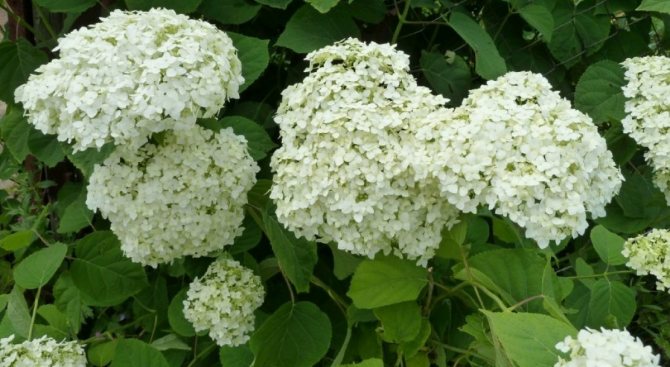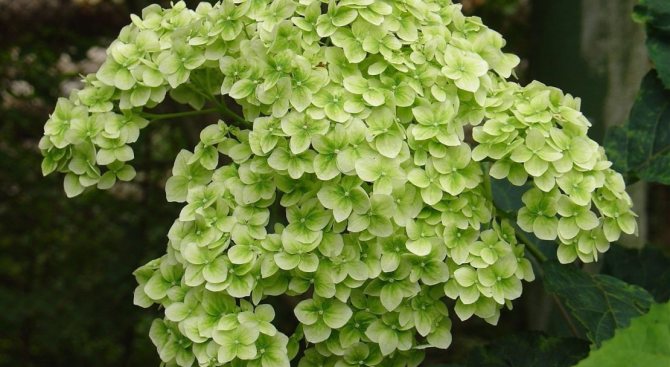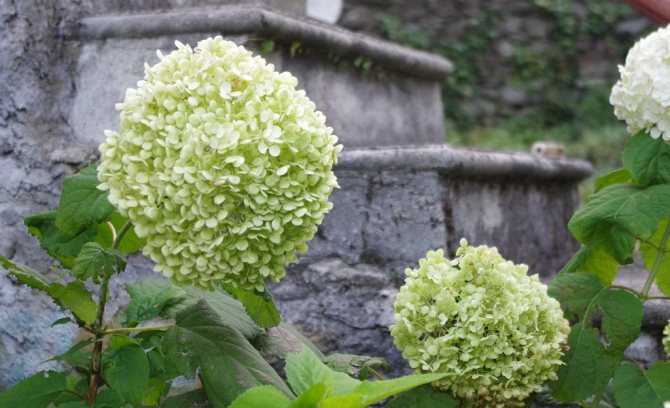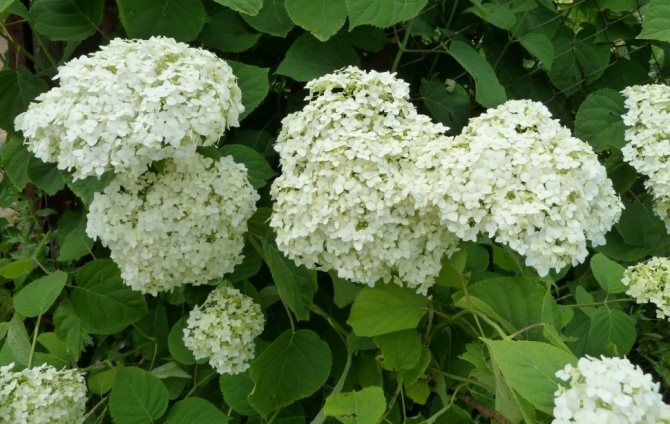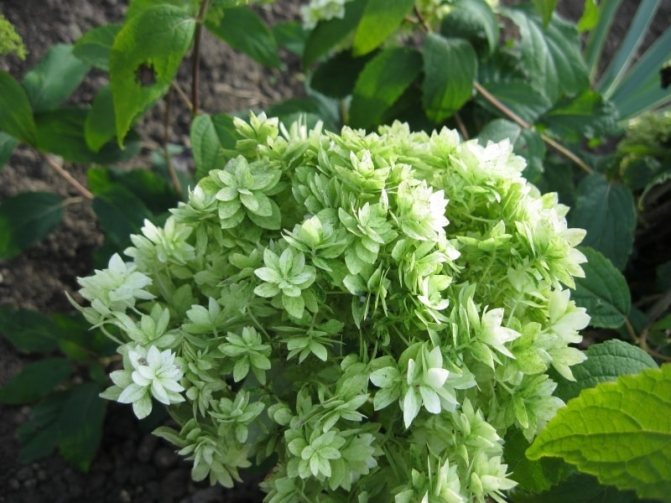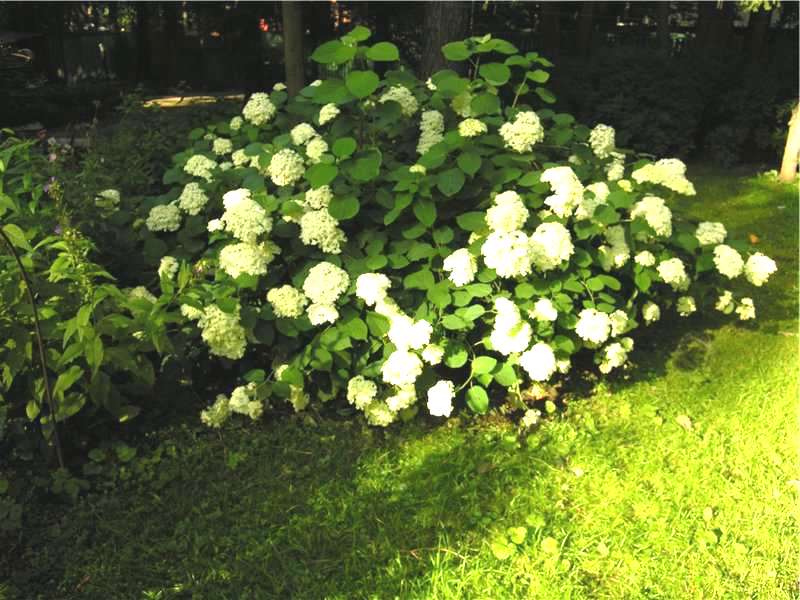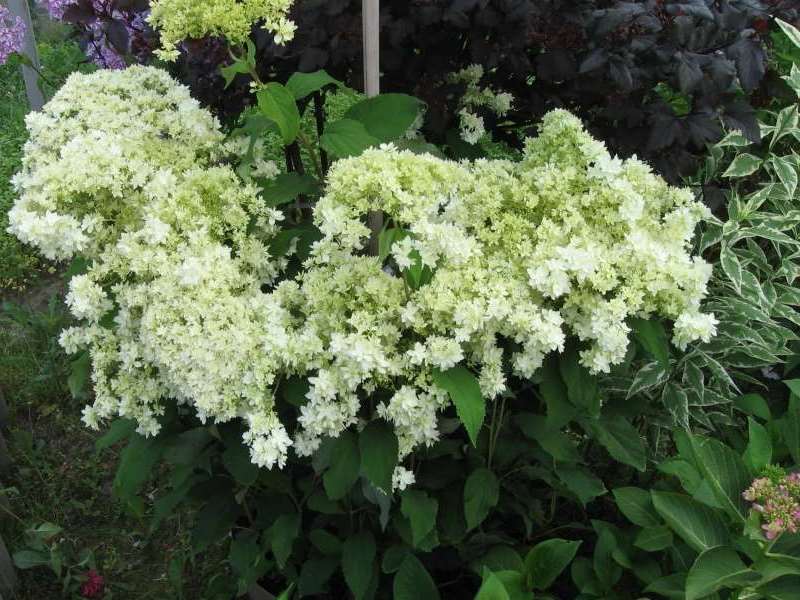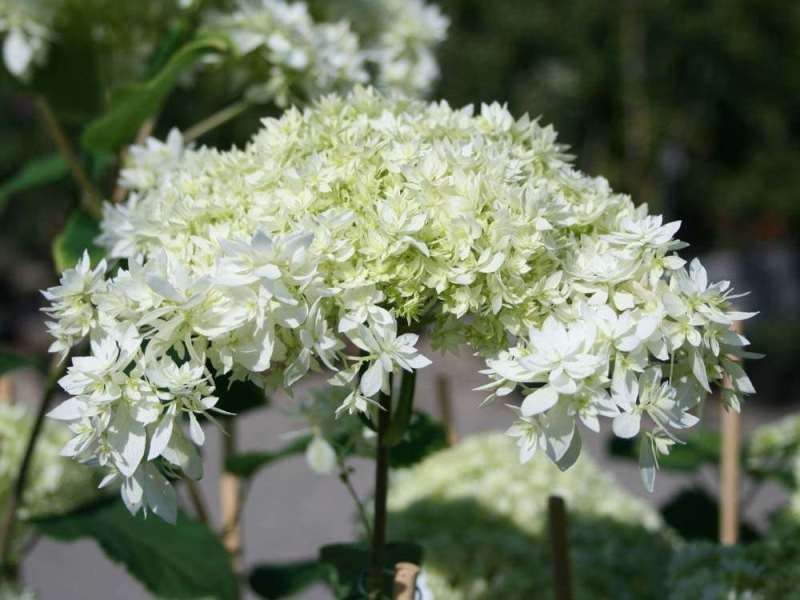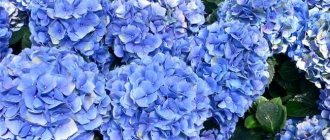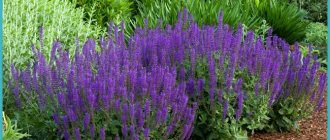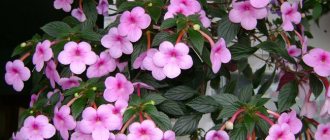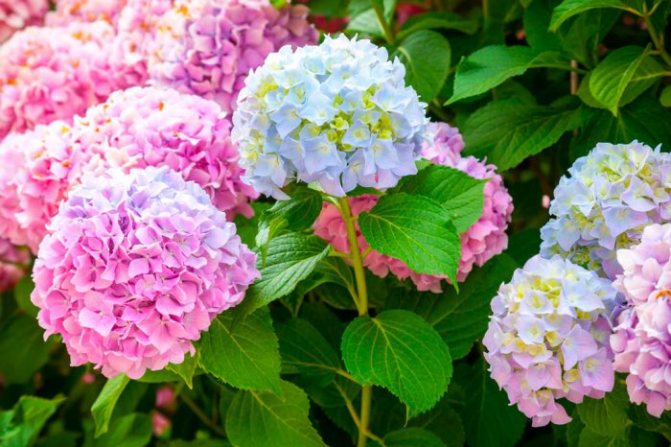
A flowering plant such as hydrangea (Hydrangea) is directly related to the hydrangea family. According to various sources, this genus unites 30–80 species of hydrangeas. Such plants are represented by compact trees, lianas and shrubs. Most of the types of hydrangeas grow in South, as well as East Asia (China, Japan), this plant can also be found in North America and the Far East. Such a plant was named after the princess of the Holy Roman Empire. Systematic scientists gave the plant the Latin name Hydrangea, which means "a vessel with water". The fact is that it is very hygrophilous. In Japan, this plant is called "adzisai", which means "flower - purple sun". Despite the large number of species, only garden hydrangea, or large-leaved, having a small size, are grown at home. Other species and varieties are grown exclusively in gardens.
Hydrangea features
In the wild, hydrangea is represented by three-meter shrubs, not very large trees, as well as lianas, which can climb up tree trunks to a height of thirty meters. Also, such hydrangeas can be deciduous or evergreen (depending on the species). In the middle latitudes, deciduous species are most preferred. Most often, such a plant has opposite leaves of a large size, they are oval in shape with a pointed tip at the top. The edge of the leaf blades is most often serrated, and venation is clearly visible on their surface. Hydrangea begins to bloom in the spring, and ends only after the onset of frost in the fall. The flowers are collected in large inflorescences, which can have a corymbose, spherical or paniculate shape. The inflorescences include 2 types of flowers. Some of them are small fertile (fertile), located, as a rule, in the middle part of the inflorescence, while others are large sterile (sterile), which are located along the edge of the inflorescence. There are species with only one fertile flowers. Most hydrangeas have white flowers. However, there are species, for example, large-leaved or large-leaved hydrangea, which can have flowers of various colors: cream, white, blue, pink, red and lilac. At the same time, it is interesting that the pH of the soil affects the color of the flower. So, for example, if the substrate is neutral, then the flowers will be cream or beige, if alkaline, then pink or lilac, and on sour - blue, because the soil contains aluminum that is easily absorbed by hydrangea. The fruit of this flower is a box with 2–5 chambers containing small seeds. It happens that a flower belonging to a close genus schizophragmatic is mistakenly called a hydrangea, but you should know that petiolar hydrangea is nothing more than a schizophragma.
General characteristics
- It is a small shrub up to 3 meters high, round in shape with drooping shoots.
- Leaves are ovoid (or elliptical), 5 to 20 cm long, and may have jagged edges.
- The front side is green, the underside is a bluish tint.
- The culture blooms from July to mid-September, has a large number of large inflorescences.
- The hydrangea tree grows quickly, is demanding on the composition of the soil, the quality of the planting material, as well as the amount of moisture received, matters.
- The plant easily tolerates frosts and severe winters.


The height of the bushes depends on the variety, as a rule, these are trunks of 1-5 meters
Growing hydrangea
How to properly grow hydrangea in the garden? Here are the basic rules:
- Large-leaved hydrangea can have a different color of flowers. Moreover, their color does not depend on the variety, but on the pH of the soil. So, in acidic soil, the flowers are blue and blue, in neutral soil they are white and beige, and in alkaline soil they are lilac or pink. In order for the bush to be spectacular and colorful, experienced gardeners are advised to change the acidity separately for each flower.
- This flower is very fond of moisture, in this regard, it must be watered not only abundantly, but also on time.
- Direct rays of the sun are required. But it should be borne in mind that flowers can fade under the influence of the scorching rays of the midday sun. In this regard, you need to choose a landing site where there is little shade at noon.
- Also, the plant must be cut off in time.
- You cannot apply a lot of organic fertilizers, because flowers may not appear on the overgrown bushes.
- Hydrangea must be covered well for wintering, even those species that are considered frost-resistant. If any of the bushes freezes, then in most cases it will be able to fully recover during the period of intensive growth.
- Very resistant to diseases and pests.
A small historical background
The first large-leaved hydrangea appeared in Europe. It happened at the very end of the 18th century. It was brought by French travelers from the Indian Ocean island of Mauritius. A participant in this first round-the-world expedition for the French was also the prince of the Roman Empire K.G. Nassau-Siegen. It is believed that he named the beautiful plant after his beloved sister.
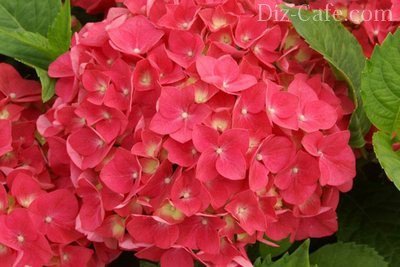

The large-leaved hydrangea was born on the island of Mauritius and appeared in Europe thanks to the first French round-the-world expedition. Such a beauty cannot be overlooked even in the luxurious governor's garden.
However, other sources claim that the bush got its name in honor of the beloved French doctor F. Commerson. There is also a less romantic version of the appearance of this name: the bush was discovered in the governor's garden. So they named it in honor of this event in Latin hortensis, which means "from the garden."
Otherwise, this moisture-loving bush is called hydrant. Translated from Greek, hydor means "water", and angeion means "vessel." Moreover, the point was not only that the bush needs frequent watering, but also that its seed pods are like a vessel - a jug. But a more palatable name gradually prevailed over Latin.
Planting hydrangeas
Growing from seeds
Seeds are usually very easy to propagate for species of hydrangea. Also, this breeding method is often used by breeders in their work. It is quite easy to grow such a flower from a seed, but it is a time-consuming method. You need to sow seeds in the autumn. To do this, you need to fill the container with a loose soil mixture rich in nutrients, which can be prepared by combining peat and leaf soil with river sand in a ratio of 2: 4: 1. Seeds sown on the surface of the substrate should be sprinkled with a thin layer of soil, and then watered with a spray bottle. Then the container must be covered from above with a transparent film or glass, while the shelter must be removed several times at knocks in order for the soil to be aired. It should also be taken into account that the soil should be slightly moist all the time. The optimum temperature is from 14 to 20 degrees. After the first seedlings appear, the shelter must be removed permanently. The pick must be done 2 times.The first time in the developmental stage of the cotyledons, and the second - in the first month of spring. At the same time, when diving a plant for the second time, you need to take small pots for each of them (diameter 7 centimeters). After you transplant young plants a second time, you need to start hardening them. To do this, flowers in the summer are taken out into the street and a place is chosen for them, which is protected from direct sunlight, gusts of wind, drafts and precipitation. In the evening, the hydrangeas are returned to the room. For 2 years, the hydrangea must be grown indoors, and in the winter it is kept in a fairly cool and lighted room, and in the summer it is transferred to the street. In this case, it is imperative to cut off all the buds, since they will take a lot of energy from a still young plant.
Hydrangea seedlings
After 2 years, at the very beginning of the spring period (in areas with a cold climate - in the autumn), the grown flowers are transplanted into open soil, immediately to a permanent place. When choosing a suitable place, do not forget that all species are photophilous and need direct sunlight. However, there are several species (groundcover, Sargent, rough and tree-like) that thrive in partial shade. The soil should be loose, enriched with organic matter, neutral or slightly acidic. Alkaline soil can be acidified by taking high-moor peat or Acid Plus acidifier. It is not recommended to plant trees or shrubs with a superficial root system next to these flowers, since after some time these plants will fight each other for water and nutrients.
The first step is to dig a hole, while its size should be 2 times the volume of the root system of the seedling together with the pulled out lump of earth. Then organic and mineral fertilizers, as well as peat, must be added to the hole, which should be mixed with the ground. Then the sapling taken out together with a lump of earth must be thoroughly shaken off from the soil and the roots should be aligned. Then it is lowered into a hole, which is covered with a mixture of compost and soil. In this case, it is necessary for the root system to rise quite a bit above the soil surface. Then the soil should be compacted, water the bush and fill the area with mulch (bark or needles).
Landing
Planting hydrangeas is quite simple and does not differ much from a similar procedure for other plant varieties. This variety gets along well even on slightly alkaline soils.
You may find it helpful to know why hydrangea grows poorly.
When is the best time to plant
Tree hydrangea must be planted in accordance with the climatic conditions of a particular region. In the northern parts of the country, it is best planted in early spring. It is necessary to guess the moment when the circulation of juice along the branches has not yet begun, but the soil has already completely thawed. In areas with a warm climate, planting is allowed not only in spring, but also in autumn, when the plant will shed its foliage.
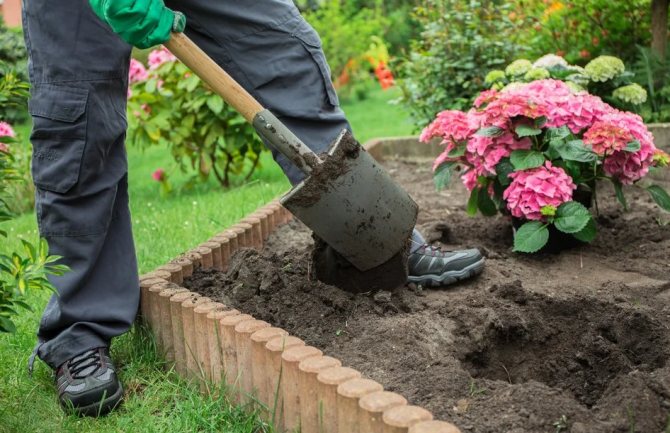

How to plant correctly
The site is chosen based on its illumination by the sun's rays... The most favorable place is considered to be where the sun is all the first half of the day. After lunch, the area may be submerged in faint shade. It is not recommended to plant in places where there are often strong gusts of wind. With constant drafts, the inflorescences of the plant wither faster.
Did you know? Hydrangea has its own day, which is celebrated by gardeners. Unfortunately, it falls on January 5, and you can see flowers at this time in our latitudes only in the store.
It is important to take care of the soil as well. It should remain slightly damp at all times, so planting near other shrubs and trees is not recommended. The optimal distance at which other species should not grow is considered to be 2 m.
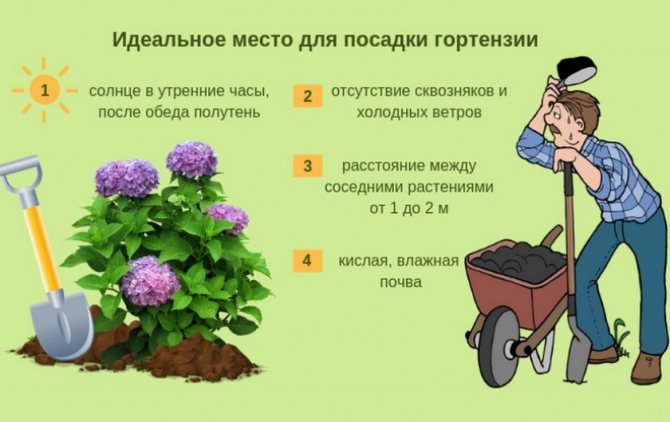

For planting seedlings, three- and sometimes four-year-old plants are chosen.... The best option would be to buy seedlings with a closed root system. If there are none on sale, then it is necessary to very carefully examine the condition of the roots. Before planting, the seedling is poured abundantly with water. Thanks to this process, it is easily removed from the container with a clod of earth. The roots sticking out longer than 25 cm are cut off. If dry or damaged branches of the root system were found, they are also removed.
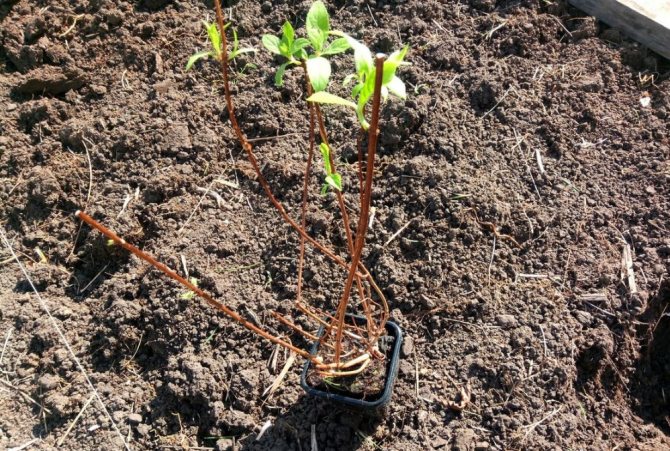

If the soil is poor, then a deepening is made in it. Its diameter should be approximately 50 cm.It is recommended to deepen into the bowels of the earth no more than 70 cm.If the soil is fertile, then the depth of the planting pit can change up to 50 cm.According to some gardeners, this indicator depends on the length of the roots and the earthen coma that is attached to them. A specially prepared substrate is poured into the center of the recess.
It consists of:
- 2 servings of black soil;
- 1 serving of sand;
- 2 servings of humus;
- 1 serving of peat.
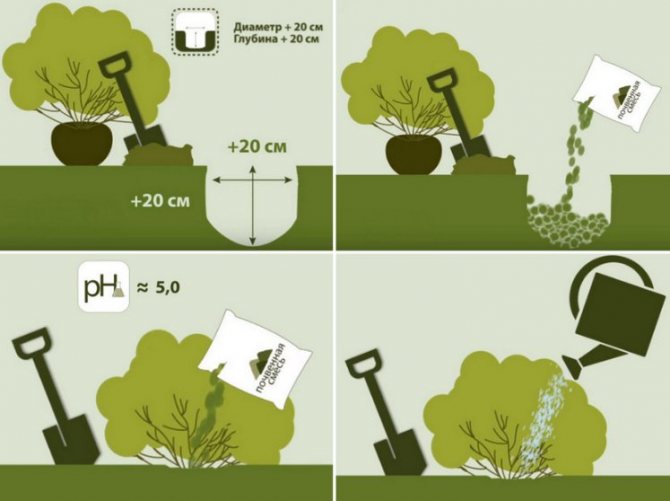

A small amount of mineral fertilizers should also be added here. Their weight should not exceed 60 g. The result should be a small mound, on which a seedling with an earthen lump is installed. The remaining substrate is evenly distributed around the perimeter of the pit. The surface of the earth is tamped quite tightly. A large amount of water is poured under the root - up to half a bucket.
Learn how to grow hydrangea from seed.
Hydrangea after flowering
A faded plant must be prepared for wintering. Seedlings that are grown in containers must be moved indoors. For flowers growing in open ground, you need to cut off wilted flowers, because when wet from rain and snow, they will become very heavy and can break branches. And it will also be necessary to spud the base of the bushes high enough, cover the soil surface around them with a layer of mulch, which will help protect the root system from freezing. The most frost-resistant species are ground cover and paniculate. The stems of such plants are completely lignified before the onset of the autumn period, which helps them to more easily endure frosts, even if they are not covered (when grown in areas with mild winters). Also, you can not cover the tree hydrangea for the winter.
Types and varieties of hydrangea
The Hydrangeaceae family includes several dozen varieties of this plant. Until now, their exact number has not been determined, because some specimens cause disagreement among experts. Most often it is a flowering shrub with attractive large leaves. But sometimes this is also called vines, and even small trees.


Surprisingly, this climbing plant is also a type of hydrangea. It looks very impressive on the exterior walls of houses in a mild climate.
As a rule, paniculate or corymbose inflorescences are formed on hydrangeas, which bloom at the ends of the shoots. On their edges are large sterile (sterile) flowers, and in the center - small fertile, that is, fruiting. In some species, all flowers are fruiting: they form large and very attractive balls.
The petals of this shrub are quite varied in color: they are white, pink, blue, red, purple and even blue. They are able to please any gourmet gardener. But the leaves are not inferior to them in their attractiveness. With proper care, they grow large, juicy and vibrant. It is difficult to refuse such beauty.
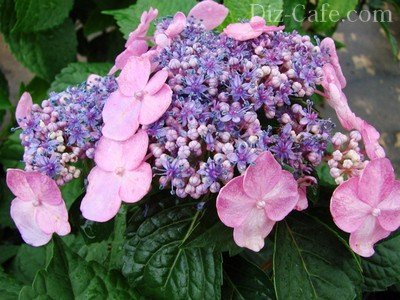

Large and catchy flowers, located along the perimeter of this inflorescence, successfully complement the small, but fruiting, which form its central part
Usually, the following types are planted in open ground: paniculate, tree-like, ground cover, garden, radiant, ash, serrate, petiolate, large-leaved and rough. Let's dwell on those varieties that are most popular in Russian gardens.
Panicle hydrangea - ice cream in greenery
Well, of course, such an inflorescence is called a panicle, and the hydrangea itself is called a panicle. The whisk really looks like soft ice cream squeezed into a waffle cup. It has a conical shape and consists of both large and small flowers. It has a length of 20-25 cm.
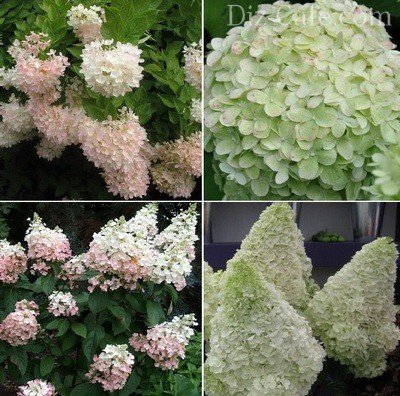

Different varieties of panicle hydrangea (from left to right): top row - Grandiflora or Pee Gee, Lime Light, bottom row - Pinky-Winky, Phantom
At the beginning of flowering, the petals of the plant are white, gradually they begin to turn pink, and before the end of the season they add slightly greenish tones to the general range. Such a change in shades is characteristic of this amazing shrub. Its leaves are elliptical. From above they are covered with a velvety down. They are even more pubescent below.
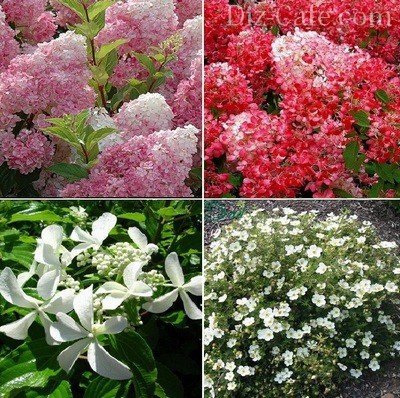

A few more varieties of panicle hydrangea (from left to right): top row - Vanilla Fraze, Diamond Rouge, bottom row - Great Star, White Lady
The flowering of the paniculate species is distinguished by its duration. It begins with early varieties in June, and with the arrival of July, this process covers all varieties. What varieties of this flower are planted in Russia?
- Grandiflora or Pee Gee. This variety can be found quite often in old gardens. Its densely packed inflorescences consist exclusively of sterile flowers.
- Limelight. This shrub can grow up to 1.2-1.6 meters in height. There is also a smaller version of it, Little Lime, up to 1 m in height. Its pyramidal greenish panicles turn slightly pink before the end of the season.
- Pinky Winky. This variety is 1.5-1.8 meters high. Differs in openwork inflorescences with large flowers, which eventually turn purple-pink.
- Phantom. This bush grows to a height of 2.5 meters. Due to the spreading crown, a little more space should be allocated to it. Its creamy panicles gradually turn pink.
- Vanilla Fraze. Its panicles are very similar to vanilla strawberry ice cream. The bush itself reaches 2 meters in height. The Sunday Frez variety is a half-sized copy of it.
- Diamond Rouge. If you haven’t come across a red-petaled variety so far, this is it. The plant reaches 1.5-1.8 meters in height.
- Great Star. Large petals of this variety are connected in the shape of a propeller and seem to float above the total mass of small ones. A very spectacular two-meter bush.
- White Lady. This variety is somewhat reminiscent of jasmine. On a bush 2 meters high, the snow-white petals look like butterflies that are about to flutter.
- Weems Ed. A magnificent variety, the flowers of which change their color three times per season. In June, they are white, then they turn pink and, finally, by autumn they acquire a rich burgundy-red color.
It makes no sense to list all varieties of panicle hydrangea, but believe me, it is exquisite in all its incarnations and variations. There is something to choose and something to work on with pleasure.


Hydrangea inflorescences often change their color throughout the season, but Weems Red is an amazing variety of this plant: it changes the shades of its flowers twice during the flowering period.
Choosing a tree variety
The tree hydrangea is also able to withstand our difficult climatic conditions. It freezes only in the most severe winters. Despite the name, it is still a shrub, and it grows in height by about 1.5 meters. Its large ovoid leaves have a notch at the base, similar to a stylized heart, and serrations along the edges. The surface of the leaf is green, and its reverse side is gray.
Here are some names:
Recent Entries
Rose Petal Jam and Its 7 Health Benefits You Likely Didn't Know About What Fruit Are You According to the Zodiac Sign 11 Best Grape Varieties That Will Help You Create Unique Homemade Wine
- Hayes Starburst. Its inflorescences consist of large double flowers, at first greenish, and later - a bright white hue. Their diameter can be up to 25 cm.Sometimes the thin branches of the bush simply cannot withstand such a weight.
- Inkerdiboll. White flowering balls on this shrub are simply striking in their gigantic size. The plant itself rises only 1.2-1.5 meters.
- Invincibel Spirit. The intense pink shade of large inflorescences seems to fade in the sun over time, gradually acquiring a noble pallor.
- White House. Large, creamy white flowers border the scutellum, the interior of which is composed of fertile flowers. The maximum height of such a bush is only 1-1.4 m.
Of course, this list does not reflect the entire wealth of choice: it only slightly opens the veil that hides many more mysterious beauties.
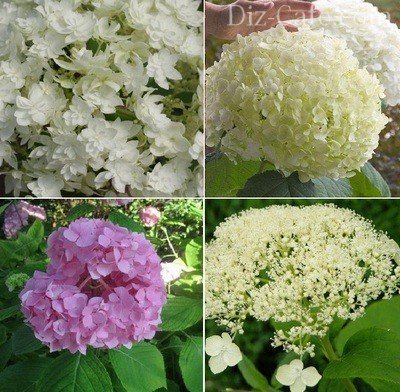

Various varieties of tree hydrangea (left to right): top row - Hayes Starburst, Inkerdiball, bottom row - Invincibelle Spirit and White House
Petiolate view to strive upward
In this variety of hydrangeas, loose inflorescences are also in the form of a shield. Large flowers in them are located at the edges, and small ones form the center. But the most amazing thing about this shrub is its rhizomes and suckers that grow on the shoots. With their help, he is able to climb the wall of knowledge to a height of 25 meters. Wide green leaves seem to cover the wall, forming a single panel.
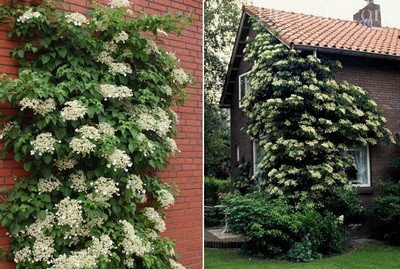

The petiolate hydrangea can be used not only as a graceful vine, but also as an excellent ground cover plant.
Unfortunately, the petioled species cannot stand our harsh winters. If in the Baltics it can be left on supports, then we will have to not only remove, but also cover. However, it can also be widely used as an excellent ground cover plant.
Such a welcome and capricious large-leaved hydrangea
This plant is a frequent visitor to domestic sites, which always pleases with a variety of colors. She has different shapes not only the flowers themselves, but also the inflorescences. The only drawback of this beauty is the need to shelter her in the winter. She can freeze and sniff, if the shelter seems excessive to her.
If it freezes in the fall or early spring, and then still leaves, then it is the flower buds that may be damaged. Therefore, it is better to still grow it in a greenhouse, and only then plant it in open ground. Let the autumn sit out in the greenhouse again, and for the winter she will have to move to live in the basement.
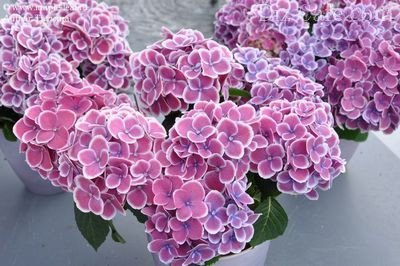

This type of hydrangea can not only be bought in a tub, but also planted right along with the tub: this way it will be easier to transfer it to the greenhouse and to the basement in the future.
Hydrangea wintering
Preparing hydrangeas for winter
A rather warm and snowy winter period allows even species that love warmth (serrated and large-leaved hydrangea) to winter without shelter. However, it should be borne in mind that winter will be frosty or warm, no one knows exactly how and how much snow will fall. It is better to play it safe and, despite the fact that forecasters promise a warm winter, prepare the plants for wintering properly. Because if the forecast of weather forecasters is incorrect, then plants unprepared for wintering may die.
What is the best time to cover this flower and how to do it? As a rule, this procedure is carried out in October, after the first frosts have passed. If the bushes are young, then they should be covered to the top with dry soil. The grown bushes must be pressed to the soil surface and covered with roofing material or lutrasil. They must be fixed with bricks, since such a shelter can be blown away by the wind. More mature bushes will require more energy. The bush must be carefully tied and then covered with spunbond or lutrasil. After that, a metal mesh frame should be created around the bush, which should have a cylindrical shape. In this case, the walls of the structure should be removed from the bush by 20-25 centimeters, and they should also rise above it by 10 centimeters.Empty space in the structure should be filled with dry leaves. In spring (in April) the net with leaves can be removed, but the spunbond is removed only after the threat of frost has passed.
Hydrangea in winter
You yourself can decide whether to cover these flowers for you or not. The options above are ideal for a frosty winter with poor snow cover. In the event that in the place where you live there is a very mild winter, then covering the hydrangea can be quite easy. And if you have winter-hardy species, then they can not be covered at all. However, if the winters where you live are often frosty, then it is better to take care of a shelter for the hydrangea in the autumn, and then you will definitely be sure that it can survive even severe frosts.
Hydrangea Sterilis: variety description
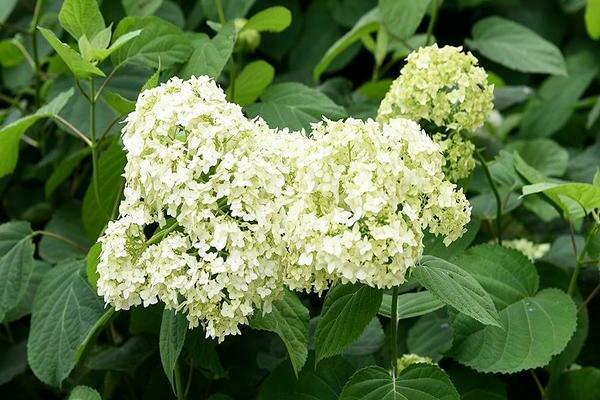

Hydrangea Sterilis sterilis: photo of the variety
Treelike hydrangea Sterilis is a member of the Hortensia family. This species came to us from distant North America. It grows wild on rocky and wooded heights, as well as in regions such as India, China, Oklahoma, Missouri and along the banks of Indiana streams.
Hydrangea Sterilis at the same time surprises and delights with its appearance and the difference in color. A shrub grows up to two meters high. The inflorescences are quite large, up to 30 centimeters in diameter. In their central part there are very small flowers, and along the edges of the largest. The buds reach three centimeters in diameter.
The foliage of the shrub has an elliptical shape, rather large and rich green color, which in some subspecies can persist until winter. And in other orts, the shoots change color to red closer to the last days of August.
Hydrangea Sterilis can perfectly harmonize with other shrubs and plants, therefore it is often used as a hedge and group compositions. Plus to all that has been said, this bush is considered quite unpretentious in growing and maintaining. Which cannot but rejoice.
Types of hydrangea photos and names
If you are thinking about decorating your garden with hydrangea, then first of all you should pay attention to the features of the various types of this plant. Then you can choose exactly the types that will best suit your garden. It is also important to know how each species needs to be looked after. For example, a tree-like or large-leaved hydrangea must be prepared for wintering and cut in a slightly different way than panicle hydrangea. If you know a lot about the rules for caring for such plants, then caring for them will not be difficult.
Hydrangea tree (Hydrangea arborescens)
This variety is very popular among gardeners living in mid-latitudes. This plant is presented in the form of shrubs. Its height can vary from 100 to 300 centimeters. Inflorescences grow on the tops of annual stems. When the flowers are just beginning to open, they have a light green color, after their full disclosure, they change their color to cream or white. The most popular varieties are: "Invizible Spirit" - flowers have a pink color; "Sterilis" - inflorescences are white, while this plant blooms very profusely; "Annabelle" and "Grandiflora" - have very large inflorescences, painted in a pure white color (note that panicle hydrangea has varieties with exactly the same names).
Hydrangea paniculata (Hydrangea paniculata)
Under natural conditions, such a plant has the shape of a tree or a shrub, the height of which can vary from 2 to 5 m. This species is considered one of the most popular among gardeners. Without a transplant in the same place, this type of hydrangea is able to grow and develop normally for more than 40 years.The stems of this plant are lignified in a relatively short time, which is why it is considered winter-hardy. The inflorescences grow in the upper parts of the stems of this year, while the flowering is distinguished by its abundance. However, the buds formed in the last days of June open only in August or September. The inflorescences of this type of flowers have a pyramidal shape. When only the flowers begin to open, they have a pale green color, and after full disclosure, they turn white. At the end of the summer period, they turn light pink, and then brick. When the flowering period begins to end, the flowers turn light green again. The most popular varieties are Grandiflora, Quishu, Vanilla Freise and Tardiva.
Large-leaved hydrangea (Hydrangea macrophylla)
Or garden - it is often cultivated in the garden. However, individual varieties can be grown in containers indoors or on the terrace. Dense leaves have a rich green color. This year's stems are herbaceous, which is why the bush is not very cold-resistant. It is believed that inflorescences appear on the stems of last year, since the buds for their growth are laid in the autumn, and they begin to grow in the spring. As a rule, the inflorescences have a viburnum-shaped, umbellate shape, it is also called hemispherical or Japanese. The color of the flowers depends on the pH of the soil. Recently appeared interesting varieties: "Endless Summer" - in acidic soil - blue color, in neutral - lilac; Renata Steinger - blue; "Expression" and "Romance" - have double flowers.
Hydrangea tree: characteristic
Description tree hydrangea (Hydrangea arborescens) has the following: refers to deciduous shrubs, usually grows up to 1.5 m (in America it can reach 3 m). Shoots are tubular, straight, leaves are green, large (in the form of an ellipse), covered with bluish pubescence below, serrate along the edge. It blooms profusely with large (15-20 cm in diameter) corymbose inflorescences (white and cream with greenish tints) from July to October. Differs in winter hardiness and rapid growth of shoots (from 20 to 30 cm per season).
Treelike hydrangea has become the basis for breeding a large number of varieties with increased cold resistance (with different flowering periods, inflorescence sizes, shades, etc.). The most popular are:
- Annabelle - blooms from June to September with dense round white inflorescences (25 cm). Crown diameter - 3 m, height - 1-1.5 m. Leaves fall green in autumn;
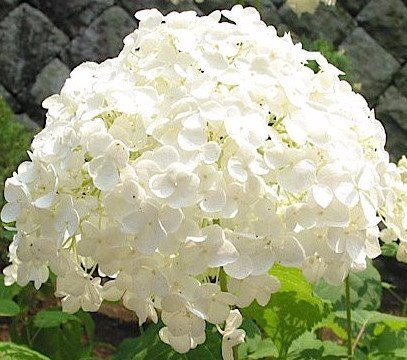

- Pink Annabelle is a selectively bred pink variety;
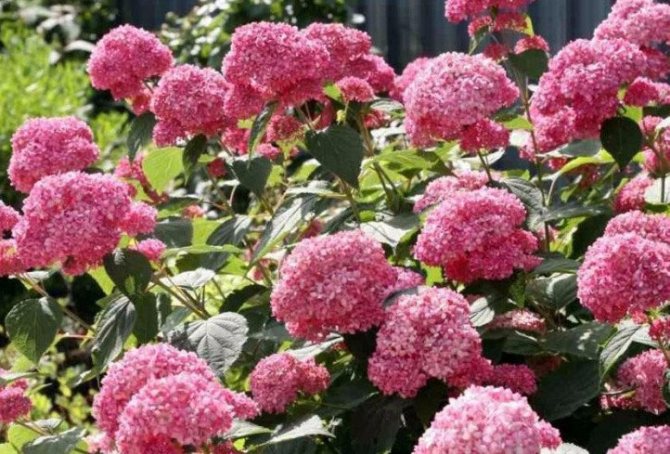

- Strong Annabelle - has strong shoots, capable of holding heavy balls of inflorescences without tying;
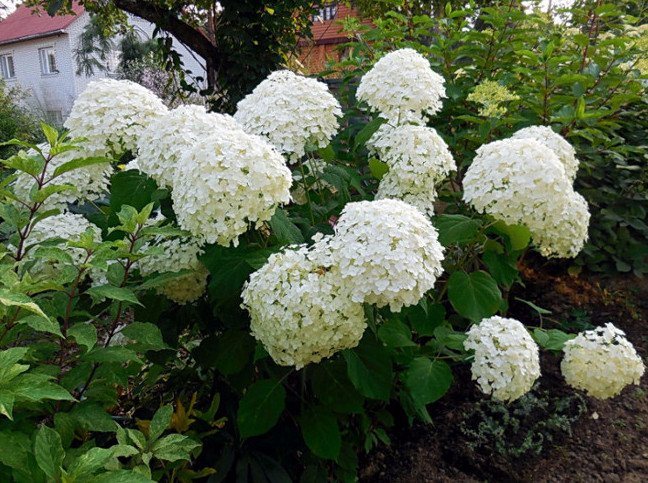

- Sterilis (Sterilis) - very abundant flowering, sterile. It can reach two meters in height. Flowers initially have a greenish tint, which changes to snow-white, blooms from July to October;
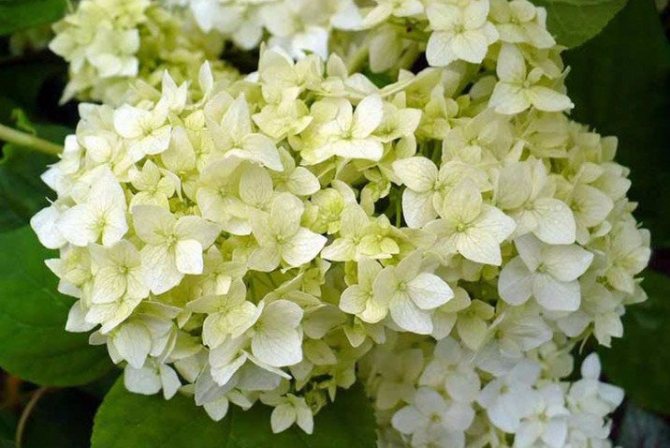

- Hayes Starburst - large inflorescences of double flowers of white shades, blooms until frost;
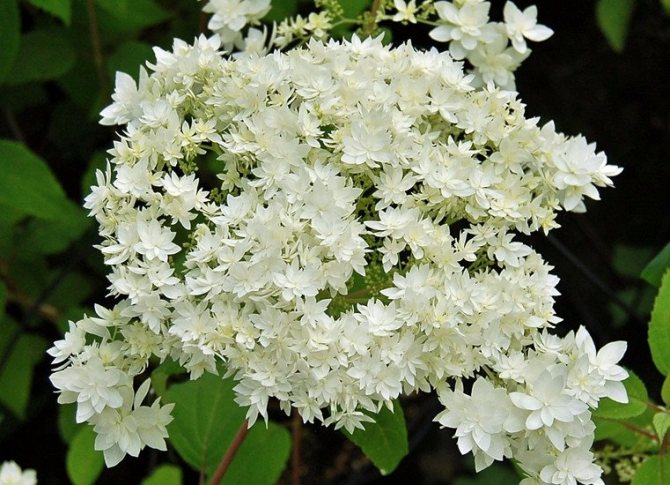

- Pink Percussion - with small inflorescences (up to 10 cm) of pink shades.
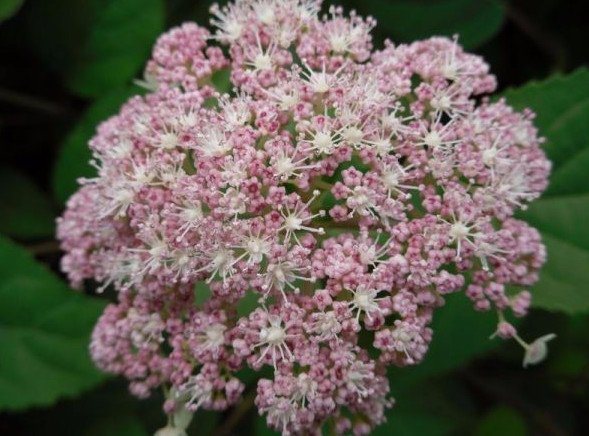

Description and characteristics of garden hydrangea
In cold climates, hydrangea is not able to grow to the size with which it pleases the inhabitants of southern Asia and Japan. Dense thickets of lianas braiding trees, and evergreen varieties of shrubs are also not pleasing to the eye. But compact hydrangea bushes, with proper care, will look no worse than if they grew in their homeland.


Lush hydrangea bushes
Hydrangea leaves are quite large, veins are clearly visible on them, the edges are often serrated, and the leaves are located on the stem opposite each other. Flowering begins in early summer, and ends with the onset of frost. Flowers are large, spherical or paniculate. Most varieties have white flowers.But the large-leaved hydrangea can change color depending on the level of acidity of the soil.
It blooms in white when the acidity of the soil is neutral; lilac and pink when alkaline. And if the soil is acidic, then the flowers take on a beautiful blue color.
The color of a plant is influenced by the aluminum in the soil, which plants are able to accumulate in themselves.
Another plant is very similar to hydrangea - schizophagma. It is also called petiolate hydrangea. But it should be remembered that in fact it is not a hydrangea and belongs to a completely different genus.
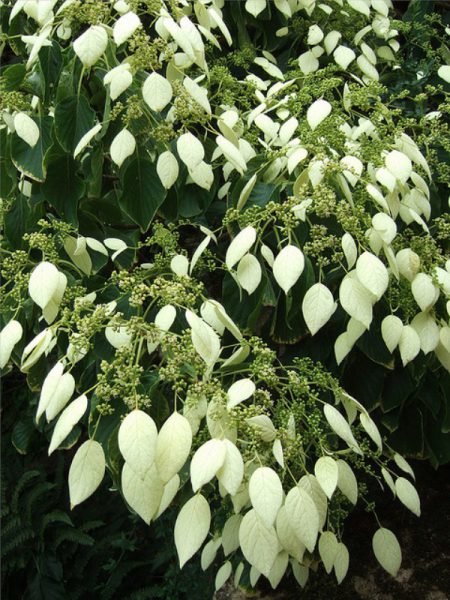

Schizophragma hydrangea
What you need to know when planting a tree hydrangea
In order for the tree hydrangea to feel comfortable in your garden, its planting should take into account the preferences of the plant. First of all, this applies to lighting and ground.
Important! Hydrangea does not tolerate transplants (especially frequent ones) - it “moves away” for a long time from the transferred stress, blooms poorly. This circumstance must be taken into account when choosing a landing site in order to make it as permanent as possible.
Plant lighting
Hydrangeas grow well in any light, but practice has shown that:
- under the bright and scorching sun (especially in the more southern regions), the size of the inflorescences decreases, the growth of plants slows down;
- a dense shadow leads to the fact that the inflorescences do not develop, become rare, flowering decreases.
The best option would be to grow hydrangeas in partial shade. An ideal landing site would be an area with midday partial shade, morning and evening sun.
Soil for hydrangea tree
The hydrangea is picky about the composition of the soil. Most of all, the plant prefers fertile loamy soils with good drainage and high acidity (all mycotrophic plants need soil fungi). Hydrangea tree of all hydrangeas best tolerates the presence of lime in the soil. The soil should not be dense, it should allow air and water to pass well (adding sand, it should be borne in mind that water in such soil will go deeper faster). With a lack of acidity, if desired, it can be increased with special additives (sawdust, coniferous soil, brown peat, etc.).
Did you know? The intensity and color of hydrangea inflorescences depends on the degree of acidity of the soil. If you water a blooming adult hydrangea twice with four buckets of aluminum sulfate solution (30 g per 10 liters of water), the white color of the inflorescences will change to blue, the pink flowers will turn purple.
Growing features
To change the color of the inflorescences of large-leaved hydrangea, it is necessary to adjust the acidity of the soil. To obtain blue flowers, the soil must be acidified, and for pink flowers it must be deacidified with lime or dolomite flour.
Flowers love the sun in the morning hours, and at noon they need partial shade so that the petals do not fade. Hydrangea must be covered for the winter. This is especially true of the large-leaved hydrangea that blooms on last year's shoots.
But pests and diseases do not affect this plant very often.
How to grow from seeds
Species hydrangeas can be grown from seeds. But, as you know, during seed reproduction, the properties of the mother plant can be lost. Therefore, this method is used for the selection of new species. The seeds are sown in the fall. The soil mixture for planting should consist of four parts of leafy soil, two parts of peat and one part of river sand.


Hydrangea Seeds
The seeds should be sprinkled with a light layer of earth and moistened with a spray bottle. Then the box with the sown seeds must be covered with foil or glass. Condensate is periodically removed from them, and crops are opened for ventilation and moistening. After all, the ground should always be moist.The most favorable temperature for seed germination is from 14 - 20 degrees. In a month and a half, seedlings will appear.
After that, the glass is completely removed. As the plants grow, a pick is made twice. The first time the seedlings dive at the stage of cotyledon leaves. And in May, a second pick is carried out with the transplantation of each plant into a separate container with a diameter of 7 centimeters.
After the last pick, the seedlings begin to harden. They are taken out during the day to fresh air, protected from direct sunlight, rain moisture and drafts. At night, hydrangeas are brought into the room. For the first two years, they will grow at home. In a cool and bright room in winter, and on the balcony in summer, but you must try to take them out into the fresh air. The buds should be torn off to prevent flowering from weakening the young plants.
Transfer to the ground
After two years, the seedlings are planted in a permanent place in the garden. Planting is done in early spring.
The landing site should be sunny, shaded at midday. Hydrangea prefers soil slightly acidic or neutral, rich in organic matter and rather loose. High-moor peat must be added to alkaline soil. Trees and bushes should not grow near the planting site.
The size of the flower pit should be twice the size of the earthen coma of the hydrangea. Fertilizers, peat and sod land are introduced into the pit. Then you should take out the seedling, lightly shake off the ground and spread its roots. Place the hydrangea in the hole so that the roots are free in it. You need to fill up the hole with earth mixed with compost. The root ball should be slightly above the level of the site. The soil around the plant is crushed, watered and mulched with bark or needles.
Video about planting hydrangeas in open ground
Reproduction of culture
Care and reproduction for hydrangea is quite difficult, but if you follow the rules, it will delight you with numerous inflorescences. How to propagate beautiful bushes? Horticultural crops reproduce in three main ways:
- Dividing the bush. Division is done in spring or autumn, just like replanting bushes. The bush is completely dug out, a young part is separated from it, which is immediately planted in a previously prepared place with fertile soil.
- Layers. As soon as the snow comes off the ground, young shoots must be laid on the ground and sprinkled with earth. The depth of the groove should be at least 10 cm. During the summer, the cuttings are fed and watered on a par with the mother bush. In the fall or next spring, the cuttings are dug up and can exist as an independent plant.
- Cuttings. This method is the most popular and demanded among amateur gardeners. Cuttings are cut in the middle of summer. A small amount of leaves should remain on the cuttings, as well as the "heel" of last year's shoot. Cuttings are planted in the ground with a mixture of black soil and sand.
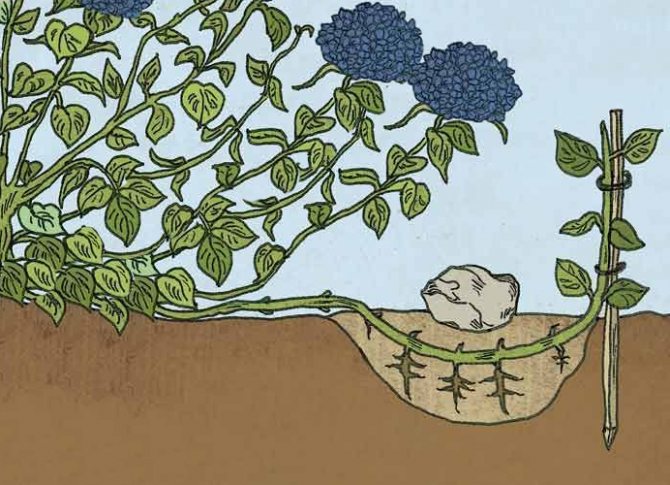

Reproduction is always done in the spring, in rare cases in the fall in any way. Photo: Reproduction of tree hydrangea can be carried out by professionals with the help of vaccination. This method is laborious and expensive. Propagation by cuttings is the most optimal period in summer.
Care and cultivation
One adult plant can be poured 30-50 liters of water if the weather is hot. Watering should be reduced if the soil around the bushes is mulched. Several times over the summer, the soil is loosened to a depth of 5 centimeters in order to improve its aeration. During flowering, it is worth removing faded shoots.
Fertilizer
Hydrangea is fed 2 times a year. In the spring, 20 grams of urea is diluted in a bucket of water and the flower is watered with this solution. Three buckets must be poured onto one adult bush. And after flowering, the hydrangea is fed with a full complex of mineral fertilizers.... In the summer, you can water the flowers with slurry, but it is very important not to overdo it, because too large inflorescences can break the stems. To avoid breaking the stems, it is better to tie them up.


Fertilizers for hydrangeas
Pruning
For the first four years, hydrangeas do not require pruning. Further pruning in early spring, when the buds are slightly swollen... The panicle is cut off by a third, the tree-like one, leaving from three to six buds, but the large-leaved one should not be cut off. This type of hydrangea blooms on the shoots of the last year, therefore, in the spring, only old and growing shoots are removed. Cuttings obtained by pruning can be rooted.


Correct pruning of large-leaved, paniculate and tree hydrangea
Treelike hydrangea: how to care for a shrub
Treelike hydrangea is unpretentious - care is reduced to watering, fertilizing, mulching, loosening the soil and pruning.
Watering the plant
The scientific name of hydrangeas - "hydrangia" - directly indicates the love of this plant for water. The root system of hydrangeas grows in a horizontal plane, and with a deep bedding of underground waters or during a dry period, the lack of moisture is immediately reflected in the developed aboveground part.
For the normal development of hydrangeas, it is necessary to water:
- regularly. The plant should receive at least 30 liters of water weekly. Mulching the trunk circle in combination with natural precipitation will help reduce water consumption;
- soft water without chlorine (hydrangeas especially like rainwater). Therefore, water for irrigation must be harvested in advance - to defend tap water and / or collect rainwater in a container;
- cold water (20-23 degrees Celsius);
- in the evening or in the morning;
- without getting on the inflorescences when watering (water makes them heavier, and the shoots can break).
How to fertilize tree hydrangea
In the first year after planting, fertilizer for tree hydrangea is not required to be applied to the soil (there are enough nutrients in the hole). In the future, it is necessary to feed regularly - at least three times a season:
- with the appearance of the first shoots (April-May) - a complex fertilizer (Fertiku, etc.) or a mixture of superphosphate and potassium sulphide (30 g per sq. m) and urea (20 g per sq. m);
- with the beginning of budding (mid-June) - a mixture of potassium sulfide (40 g per sq. m) and superphosphate (70 g per sq. m). A good nitrogen feeding will be mullein infusion (7 kg of manure per 3 liters of water to insist for 4 days) - 1 liter per bucket of water;
- during flowering (end of August) - organic fertilizers (compost, rotted manure).
In September, it is no longer necessary to feed - the plant enters the stage of dormancy and preparation for wintering.
Caring for the soil in the garden
The soil needs periodic loosening (so that a dry crust does not form and the access of air and water to the roots is not obstructed). The earth is loosened (by 5-8 cm) around the hydrangea with a radius of 60 cm. You need to loosen it two or three times during the summer. Weeds are weeded at the same time.
Pruning a tree hydrangea


As practice shows, it is not difficult to properly cut a tree hydrangea, however, this must be done already from the first year after planting (provided that the plant is 4-5 years old).
Pruning can stimulate growth and increase the number and size of inflorescences. The main time to prune a tree hydrangea is in spring (from the moment the snow melts to the beginning of the opening of the leaves).
In the spring, the following types of pruning are carried out:
- sanitary (after wintering, dried, frozen or broken shoots are removed);
- rejuvenating (for plants aged 5-6 years and older - cutting under the base of old shoots with weak growth);
- thinning (the fight against thickening - removal of small, weak, growing towards the center and other shoots).
In the fall, only shortening pruning is carried out (last year's shoots).
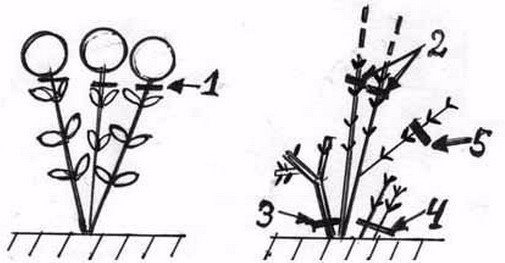

Some gardeners recommend doing the main pruning in the fall. Treelike hydrangea does not tolerate pruning before wintering, and pruning in the fall is undesirable - it may not recover and freeze in winter.
Did you know? Inflorescences cut during autumn pruning are perfect for making dry bouquets. When properly dried, hydrangea flowers retain their color: remove all leaves from cut shoots, hang them down in inflorescences in a dark room with good ventilation. To keep fresh cut hydrangea flowers in a vase for a longer time, you must also tear off all the leaves, split and burn the end of the shoot.
Propagation by cuttings
There must be two nodes on the handle: the lower cut is made oblique, and the upper one is straight. The distance from the cut to the knot is about 2 centimeters.
They are planted in a small container with wet sand and peat soil. Cuttings are deepened by three centimeters, you can first powder them in "Kornevin" to stimulate root formation. The seedlings should be watered and kept moist at all times. From above, the cuttings are covered with a film, from which condensation must be regularly removed. After about a month, rooting will occur and the hydrangeas can be planted in a permanent place. In the first winters, even frost-resistant varieties need shelter.
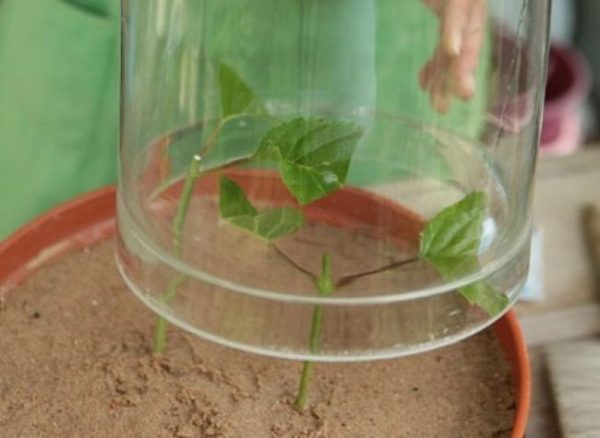

Propagation of hydrangea by cuttings
Reproduction
There are several ways to reproduce Sterilis:
- Cuttings. A high percentage of rooting occurs when working with green cuttings. Especially after processing them with a solution of indolylbutyric acid. Hydrangea cuttings must be cut before lignification in two periods - early June and mid-July, then processed and planted in a cuttings.
- Rooting of layers. In the spring, dig a small hole near the bush, bend the shoot, cover with earth with a layer of 2 cm. Fix in a convenient way. Leave the end of the escape looking up. Over the season, add soil several times and regularly water the layers.
- Division of the bush. Dig up the hydrangea, divide the root system, plant in new holes.
When propagated by cuttings and layering, Sterilis blooms at 4 years old.
How to prepare flowers for winter in the fall
In the fall, potted plants must be brought into the house. Garden hydrangeas mulch and huddle. The inflorescences and lower leaves must be removed. Removing the lower leaves contributes to the lignification of the shoots and the improvement of their frost resistance. Ground cover and panicle hydrangeas are the most frost-resistant and do not need shelter. Also in the central regions, tree hydrangea can do without shelter.
It is enough to cover young plants with a thick layer of dry earth and foliage. Planks are placed around adult plants and shoots are pinned to them. The top is covered with foliage, spruce branches, spandbond and boards. You can also put tree branches on the bushes so that the snow on this place lasts longer. After winter, the shelter is removed gradually. Spandbond is harvested last when there is no danger of recurrent frost.
The main pests and diseases of hydrangea tree
Treelike hydrangeas, with proper care, rarely get sick.
High humidity, a decrease in temperature can provoke infection with fungal diseases (especially if there is a source of infection) - false and true powdery mildew, white and gray rot. First of all, leaves and flowers are affected. Copper oxychloride (HOM), Bordeaux liquid, "Fundazol", "Chistotsvet" and others help against fungal diseases.
Of the pests, garden snails, spider mites and aphids do the most harm:
- snails infect buds, buds, young shoots and leaves (especially dangerous in early spring, when they climb into wintering bushes). The fight is carried out by hand assembly, laying traps with chemicals (metaldehyde or "Thunderstorm") near the hydrangea;


spider mite infects leaves, shoots. Infection occurs with increased dryness of the air. During treatment, various insecticides and acaracides are used (Akarin, Tiofos, Molniya, Vermitic, etc.). From the folk methods of struggle - treatment with soapy water, mineral oil;- aphids suck juice from young shoots, buds.Used in the fight against it "Inta-Vir", "Actellik", "Fitoverm" and other drugs. From folk methods - processing with an infusion of garlic (200 g of crushed garlic per 10 liters of water to insist for 3 days, add 40 g of soap).
Did you know? Hydrangea flowers are divided into sterile, or sterile, and fruitful. Sterile petals attract insects, decorate the plant, can form a border, can be dispersed over the inflorescence. Throughout the season, their pigmentation changes - greenish shades turn into snow-white, then pinkish ones appear. Small-sized fruiting flowers are located in the center of the inflorescence, and their color does not change.
Hello dear readers!
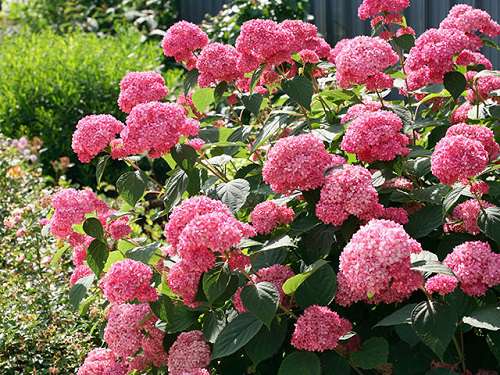

In the previous article on hydrangeas, we got acquainted with its species and varieties, with the requirements for growing these lovely flowers.
The question of how to breeding hydrangea... Of course, the easiest way would be to buy a seedling in a nursery.
But, firstly, it is still an expensive pleasure; secondly, there is not always the variety that you like and, thirdly, the very process of hydrangea breeding is also a very exciting experience.
well, like this how does hydrangea multiply? There are at least five ways to reproduce it: by seeds, cuttings, layering, offspring, dividing the bush.
Let's get to know each of them a little.
Diseases and pests
Most often, hydrangea suffers from negative effects spider mite... Also, it may appear on it and green aphid. Both of these insect species feed on plant sap. Since folk remedies are not always effective, it is better to immediately attend to the purchase of chemicals.
There are a lot of them, and you have to choose from the most common:
- Aktara;
- Actellik;
- Sunmight;
- Fitoverm.
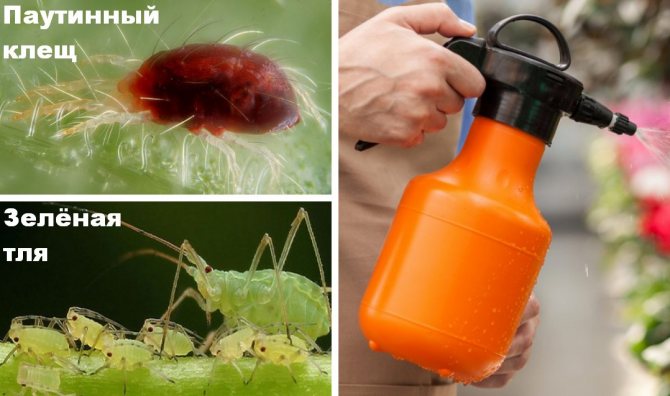

Of the most common diseases emit powdery mildew, chlorosis and peronosporosis... These fungal ailments are treated with fungicides.
The following drugs are considered to be the most popular in our country:
- Bayleton;
- Fitosporin;
- "Quadris";
- Alirin-B;
- "Topaz";
- "Gamair";
- Fundazol.
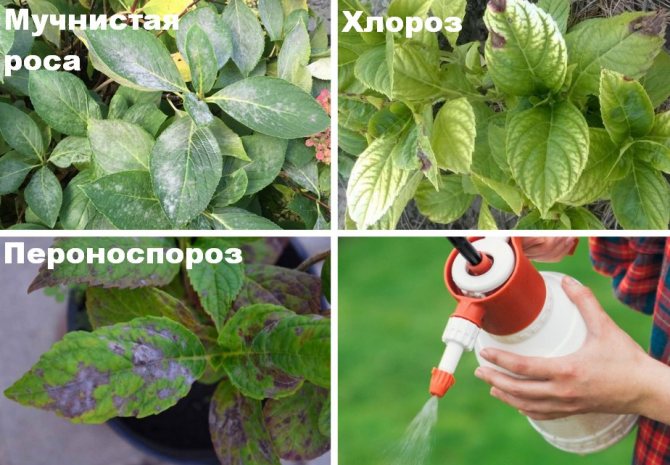

A solution of them is created according to the instructions, which are necessarily indicated on the package. An important factor is the exact observance of proportions, since the plant may not only fail to heal, but also suffer more. Chlorosis is usually the result of a lack of iron in the soil or excessive fertilization with manure. A clear sign of an ailment is considered to be colorless spots on the foliage.
Propagated by seeds
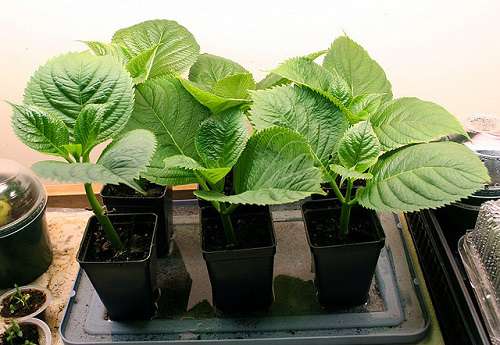

Hydrangea seeds do not require pre-sowing preparation, so they can be sown directly into seedling boxes.
It is not worth planting seeds in the soil. Immediately after sowing, cover the box with glass or plastic wrap. At the same time, of course, do not forget that the soil must be moist.
Seedlings will appear in about 20 days. Then we grow the seedlings for two years and only in the third year can they be planted in a permanent place in our garden. By this time, our seedlings should be 30-40 cm high.
Keep in mind that only natural seeds reproduce well. hydrangea, and the varieties bred by breeders with this method of reproduction lose their acquired decorative qualities.
Since we will obviously be engaged in the reproduction of varietal hydrangeas, we will consider the following methods in more detail.
Use in landscape design
Hayes Starburst hydrangea is often found not only on personal plots, but also on city streets. She decorates the flower beds of streets, parks and squares. The shrub can be combined with various types of conifers, phlox, geraniums and some other flowers. In some gardens, it is used to create hedges. Suitable for planting in group compositions. It is found as a solitary plant for decorating the lawn.
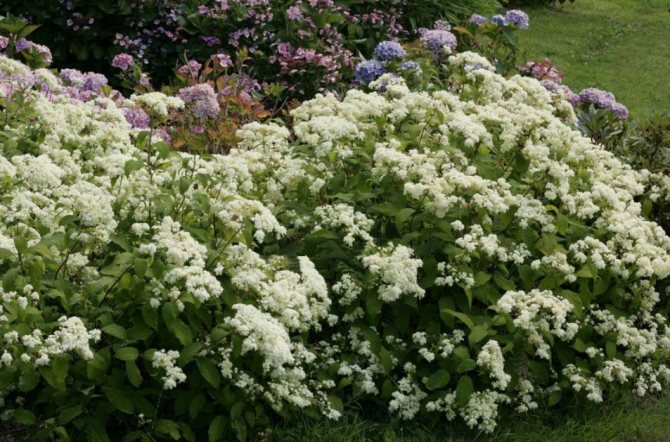

No one will say that hydrangea is devoid of attractiveness.This plant will delight the owner for a long time, giving delicate flowers and aroma almost all summer. Nevertheless, she needs to be looked after closely. And to facilitate this process, you should memorize the information specified in this article.
The best way is with green cuttings
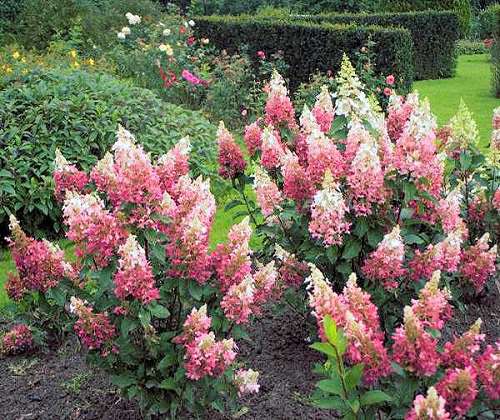

This way breeding hydrangeas is the most common among summer residents.
It is best to do green cuttings at the moment when the buds appear - this is about mid-July.
Let's define what a green stalk is. It is a leafy part of the stem with one or more buds.
I advise you to only cut the cuttings from young plants. If you already have old bushes, then you must first carry out anti-aging pruning.
Also, note that cuttings cut from lateral shoots (grown on last year's growths) in the lower part of the crown take root better, but it should be well lit. Such cuttings have fairly well-developed large buds and no signs of any disease.
Another very important point is the preservation of moisture in the tissues in the cut cuttings, since the success of rooting largely depends on this. To do this, we cut off the shoots in the early morning, at this time all the tissues of the plant are still filled with moisture, and then, in the process of further work with the cuttings, we carefully make sure that they do not dry out.
We immediately put the cut shoots in the water in the shade and start cutting the cuttings as soon as possible. Cut off the green top with a bud at the shoot, since it is not suitable for a cutting.
Divide the remaining green part of the shoot into several parts with 2-3 pairs of leaves. After that, we remove the lower leaves from the cutting, and shorten the upper ones by half and carefully put the cuttings in a solution of some root growth stimulator so that the leaves do not get into the solution.
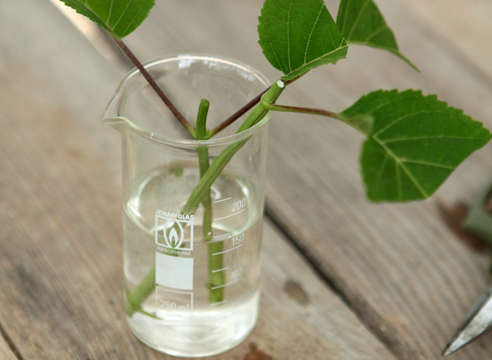

This can be, for example, root, heteroauxin, or zircon. We make the solution strictly according to the instructions and keep the cuttings in it for 2 hours, preferably in a dark place.
If you did not have any root former at hand, then I advise you to prepare such a solution: dissolve 1 teaspoon of honey in one glass of water. Honey promotes the rapid formation of callus - a thickening at the end of the cutting, from which the roots grow.
Now you can start planting the prepared cuttings. We plant their prepared in advance a mixture of peat and sand (2: 1), pre-moistening it. For better rooting, you can cover the cuttings with jars and water them directly over the jars a couple of times a week (in the absence of rain).
If the weather is very hot and dry, it is advisable to water the cuttings every day. Cuttings that you have not covered, it is advisable to spray twice a day.
Usually, after 25-30 days (approximately by the second half of August), the cuttings take root and new leaves appear on them.
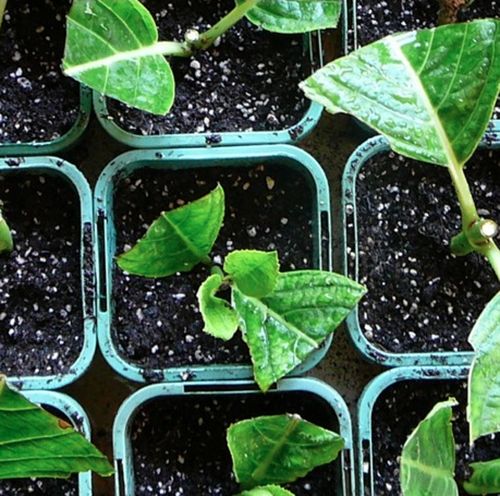

Banks can already be removed from them, but it would be better to cover the seedlings with several layers of any covering material so that early autumn frosts do not damage our still very young plants.
They also need to be well covered for the winter. We fill the seedlings with fallen leaves, then set a low frame above them and cover it with a covering material.
For better snow retention, you can additionally put spruce branches on top.
In the spring, we plant already rooted cuttings in the garden for further growing. We plant seedlings in a permanent place when they grow up enough.
Planting and caring for hydrangea Hayes Starburst
The Hayes Starburst hydrangea variety is considered unpretentious. However, the health of the plant, and, therefore, the duration and abundance of its flowering depends on how correctly the place for planting the bush is determined and what measures are taken to care for it.
A brief overview of the characteristics of the hydrangea variety Hayes Staburst and the preferred conditions in the garden for this plant in the video
Selection and preparation of the landing site
The site where it is supposed to plant Hayes Starburst hydrangea must have the following characteristics:
- semi-shabby throughout the day, but at the same time it is well illuminated by the sun in the morning and evening;
- protected from gusts of wind and drafts;
- the soil is light, fertile, humus, slightly acidic, well-drained.
Hydrangea Hayes Starburst is photophilous, but at the same time it can grow in shaded places. However, in case of excess bright sunlight, the flowering period of this plant will be shortened by about 3-5 weeks. If the bush is constantly in the shade, then the number and size of its flowers will be less than under optimal conditions.
Ideal for hydrangea Hayes Starburst - planting in the north, north-east or east of the garden. It is desirable that there is a fence, building wall or trees nearby.
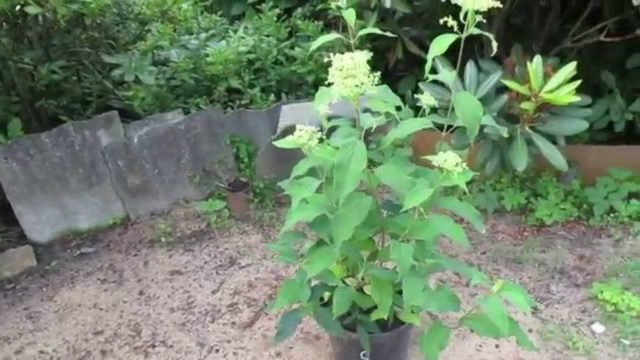

A correctly chosen planting site is the key to a lush and long-lasting hydrangea bloom
Important! Due to the fact that tree hydrangea is very hygrophilous, it is not allowed to plant it near plants that absorb water from the soil in large quantities.
Landing rules
The time for planting hydrangea Hayes Starburst in an open area depends on the climatic region:
- in the north, this is done in early spring, as soon as the ground thaws enough;
- in southern, warmer conditions, seedlings can be rooted in the ground either in the spring, before the buds swell, or in the fall, immediately after the leaves fall.
It is optimal to choose young 3-4-year-old plants with closed root system for planting.
A warning! The distance between the hydrangea bushes on the site must be maintained at least 1 m, and at least 2-3 m must remain to other trees and bushes.
Immediately before planting, the Hayes Starburst seedlings should be removed from the containers, the roots should be cut by 20-25 cm, and damaged and dry shoots should be removed.
The technology for planting a tree hydrangea in the ground is as follows:
- it is necessary to prepare a landing pit approximately 30 * 30 * 30 cm in size;
- pour a nutritious mixture of 2 parts of black soil, 2 parts of humus, 1 part of sand and 1 part of peat into it, as well as mineral fertilizer (50 g of superphosphate, 30 g of potassium sulfate);
- install a plant seedling in the hole, spread its roots, making sure that the root collar remains at the level of the soil;
- cover with earth and gently tamp it;
- water the plant abundantly at the root;
- mulch the near-trunk circle with sawdust, peat, needles.
Watering and feeding
The root system of Hayes Starburst hydrangea is shallow and branched. This plant is very moisture-loving and needs regular watering. Drying out of the soil under it must not be allowed.
The frequency of watering is approximately as follows:
- in a dry, hot summer period - 1-2 times a week;
- if it rains, it will be enough once a month.
One-time water rate for one bush of Hayes Starburst hydrangea is 15-20 liters.
Simultaneously with watering, the soil should be loosened in the near-stem circles of the plant to a depth of 5-6 cm (2-3 times during the season), as well as weeds should be weeded.


Small double flowers of hydrangea Hayes Starburst in shape resemble stars
Hayes Starburst hydrangeas work well with almost any dressing, but in moderation. Fertilize it according to this principle:
- the first 2 years after planting in the ground, it is not necessary to feed a young plant;
- starting from the third year, in early spring, urea or superphosphate, nitrogen, potassium sulfate should be added under the bushes (you can use a ready-made fertilizer mixture enriched with trace elements);
- at the stage of bud formation, add nitroammophos;
- during the summer, every month you can enrich the soil under the plants with organic matter (infusion of chicken manure, rotted manure, grass);
- in August, fertilization with nitrogen substances should be stopped, limiting ourselves to compositions based on phosphorus and potassium;
- to strengthen the shoots during this period, it is necessary to spray the leaves of the plant with a weak solution of potassium permanganate.
A warning! Before and after fertilizing the soil, Hayes Starburst hydrangea must be watered.
It is also important to know that you cannot feed this plant with lime, chalk, fresh manure, ash. These fertilizers greatly reduce the acidity of the soil, which is unacceptable for hydrangeas.
Pruning hydrangea tree-like terry Hayes Starburst
The first 4 years, you do not need to prune the Hayes Starburst hydrangea bush.
Further, regular pruning of the plant is performed 2 times a year:
- In the spring, before sap flow begins, diseased, broken, weak branches, shoots frozen in winter are removed. At the budding stage, the weakest branches with inflorescences are cut off so that the remaining inflorescences are larger.
- In the fall, before the onset of winter, they thin out the dense growth, remove the umbrellas that have faded. Also during this period, the shoots that have grown over the year are reduced by 3-5 buds.
In addition, every 5-7 years it is advised to carry out sanitary pruning of the plant, cutting off the processes by about 10 cm.
Preparing for winter
In the northern regions, before the onset of winter, the Hayes Starburst hydrangea bushes mulch with dry foliage and spud the earth. In a southern climate, this procedure is carried out during the first 2 years after planting in open ground. It is also allowed to cover plants for the winter with coniferous spruce branches or to insulate them with a covering material.


So that the branches of the Hayes Starburst hydrangea do not break under the weight of the adhered snow, they are tied together, after carefully bending them to the ground
Propagate by layering
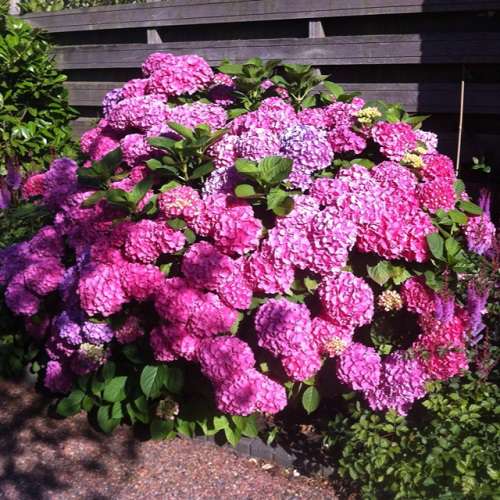

It is best to start the propagation of hydrangeas by layering in early spring, even before bud break.
First, we dig the soil around the bush, then level it well. We make radial grooves with a depth of 1.5-2 cm and put in them one shoot from the bottom of the bush.
To prevent the branches from straightening, we pin them with specially made slingshots and lightly sprinkle them with earth.
For a faster appearance of roots, you can apply the following technique: on the layers in front of the first well-developed bud from below, we make a constriction of thin soft wire in 2-3 turns, then when the shoot thickens, our constriction will be pressed into the bark and roots will appear in this place.
By the end of summer, several young shoots should have formed on each of our layers.
When they reach a height of 15-20 cm, they must be hilled, then we repeat the hilling every 7-10 days. And we do this until the height of the mound becomes 20-25 cm.
In October, we dig out the layering and separate the formed shoots from each other. By this time, their height should be about 50 cm.
We dig in the seedlings, and in the spring we plant them on the garden bed. And only after a year they will be ready for landing in a permanent place.
Hayes Starburst variety description
This tree-like shrub was first found in the southern and eastern territories of the United States of America. In nature, it is often found in the south and east of Asia, the north of the United States. Most of the plants are recorded in Japan and China. It should be added that the variety was first discovered by a resident of Alabama H. Jackson.
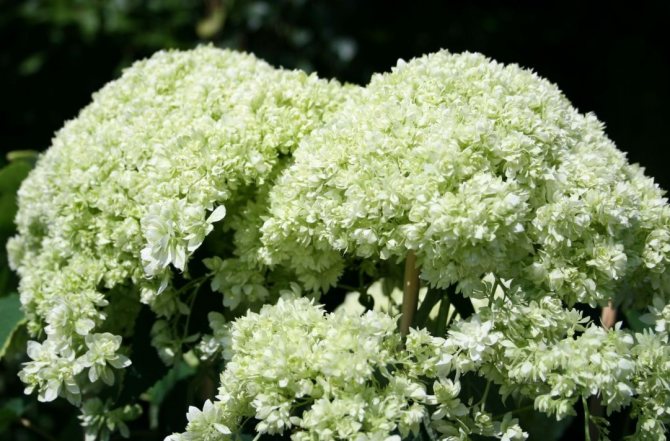

Hydrangea Starburst can grow up to 3 m. At the same time, the minimum height is only 1 m. The crown of the shrub is round. Its diameter ranges from 140 to 150 cm in an adult plant. Inflorescences are located at the end of the branch. Their diameter can reach 25 cm. By themselves, they are quite lush. They often resemble a ball, a hemisphere and a flat pyramid in shape.
Did you know? If you acidify the soil only on one side of the shrub, then the future inflorescences will change color. In this way, you can get different shades on the same bush.
Hydrangea leaves of this variety are large. Their length can reach 20 cm. Usually they grow oblong or elliptical, less often ovoid.Their edges are serrated, but not sharp. The very middle resembles a heart in shape. The upper surface has a characteristic dark green color. The lower part is gray. By mid-autumn, the foliage becomes lemon-green in color.
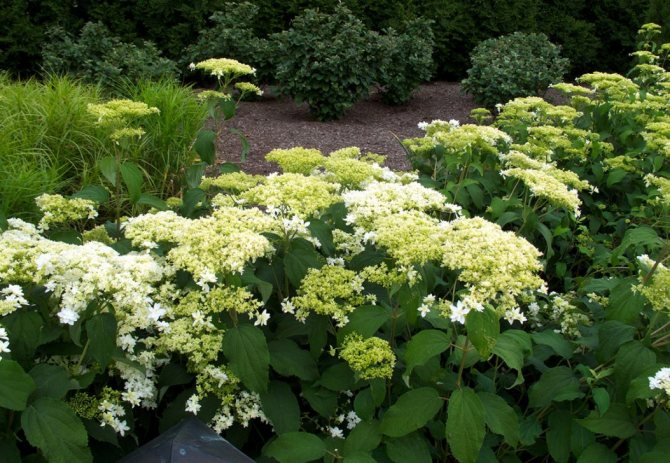

The stem of the plant usually grows upright... It does not differ in increased strength and breaks easily. Quite often, the shoots sag under the weight of the inflorescence. In this case, special supports or additional circular mountings are created for them. It is this feature that is one of the main disadvantages of the variety.
Reproduction by offspring
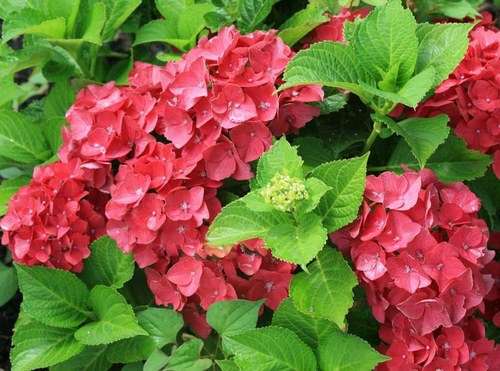

The hydrangea also reproduces well with the shoots. This method of propagation of hydrangeas requires a lot of care and attention.
To do this, in the fall, we remove the top layer of soil and very carefully so as not to damage the roots of the mother bush, we separate the coppice shoot.
We plant the separated shoots in a garden bed and leave them there for growing, depending on the condition of the seedling, for one or two years.
Testimonials
Most reviews of Hayes Starburst can be found on foreign sites. In our country, the variety is just beginning to take root fully. From the reviews that we have, it becomes clear that:
- this hydrangea is very unpretentious;
- in the first year after spring planting, you can never wait for flowering;
- under the scorching sun, the number of flowers is greatly reduced.
Little has been said about disease. From this we can conclude that Hayes does a good job with them.
Hayes Starburst pictured
We transplant and divide the bush
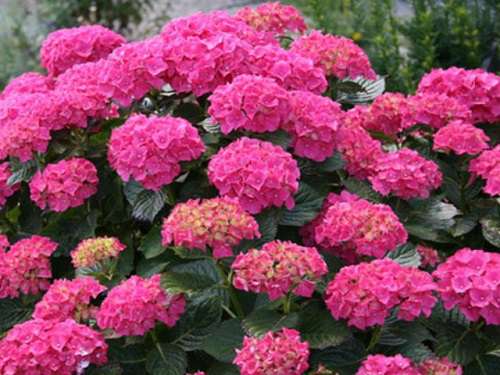

This breeding method is used mainly when transplanting hydrangeas.
It can be used for all types of hydrangeas except paniculate. It is best to do a hydrangea transplant in early spring.
First, we water the bush abundantly, then dig it out and thoroughly wash the roots from the soil.
Now you can divide the bush into several parts and immediately plant the divisions in a permanent place, cutting off the ends of the shoots and roots.
Winter hardiness of hydrangea Sterilis
Gardeners know that most of the hydrangeas are grown in the south. The heat-loving nature of this plant does not allow it to survive at very low temperatures. The sterilis tree variety is able to withstand the cold for 2 months.
Important! Even when freezing in the harsh winter, Hydrangea arborescens Sterilis recovers quickly.
You can help the Sterilis hydrangea regain vitality by timely feeding and competent pruning. The main thing is that the bush is protected from dry winds.
Experienced gardeners advise
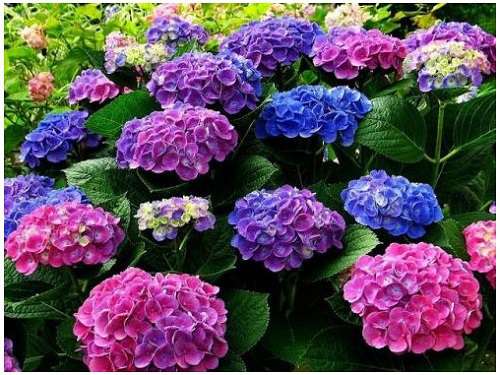

About this method of propagation of hydrangeas, which Victoria Barabash shared with us, I recently read in a gardening magazine. Very budgetary and original!
If you bought a hydrangea seedling in the fall, then it is just for you.
So, we cut off all the leaves on the seedling, cut off the unripe green shoots and take it out of the container.
Now it must be buried in a prepared trench. We make a trench of such a size that it is possible to lay a seedling in it obliquely, with the condition that the root ball is lower and the branches are higher.
First of all, we cover the roots with earth and compact well. Then we spread out all the branches of the seedling in a fan and also cover them with earth.
To prevent our seedling from freezing in winter, we cover it on top with another layer of peat or humus.
As soon as the bright spring sun warms the earth, the buds will grow on the branches of our buried hydrangea.
At first, new shoots will receive nutrition from the common root system, and in the future they will form their own roots.
At the end of summer, dug in this way, we dig out a hydrangea bush and separate the formed new shoots with their own root system.
So, having buried one plant, we can get ten new seedlings with well-developed own roots.
Now, dear readers, you have learned how hydrangea multiplies and you can successfully plant on your site a few more varieties of this magnificent plant that you love, or even replenish your budget by growing seedlings for sale.
And I also propose to watch a very good video about the propagation of hydrangea by cuttings, in order to visually consolidate the information received.
Hydrangea Sterilis: the pros and cons of the variety
Like any other plant and shrub, this type of hydrangea has its own advantages and disadvantages. Let's consider them.
The benefits include:
- Quite a high level of cold tolerance compared to other varieties.
- Almost all cuttings take root well.
- It has excellent development on slightly acidic soils, and also has a moderate level of resistance to the presence of lime in the soil.
- After a fairly cold winter, they can grow well.
But this species also has its disadvantages, here they are:
- Have a high probability of infection with diseases of a fungal nature.
- The stems tilt towards the ground and can break under the weight of their inflorescences.
Rule # 6. Regular pruning of tree hydrangea
In order for the treelike hydrangeas blooming on the shoots of the current year to please with even more large inflorescences, and the bushes to look massive and thick, the plants must be cut off annually:
- remove dry or damaged shoots;
- shorten all branches by 10-20 cm, and young growth by a third of the height.
Both sanitary and flowering-stimulating pruning are carried out at the same time - in early spring, and in March-April, at the beginning of the swelling of growth buds. But you should not rush to pruning: the first pruning is started on hydrangeas that have reached the age of four. If there is an urgent need to prune young treelike hydrangeas, then the cleaning procedure is carried out only after the leaves have unfolded.
If you want to form a denser or sprawling bush of tree hydrangeas with strict contours, pruning can also be carried out only after four years. Active sap flow when formed on young bushes leads to serious injuries and even death.
You can read more about the methods of forming and pruning hydrangeas in the material: Forming and pruning hydrangeas.


Pruning hydrangeas. <>
Rule # 3. Mulching and mulching again.
The tree-like moisture-loving hydrangea, even with optimal irrigation organization, does not like heat too much. And if you can compensate for the lack of water in the soil in the summer with careful care, then you can protect it from overheating of the roots only by mulching. And not everyone can afford the active care of a flowering shrub: using such a simple procedure, you can simplify the procedures as much as possible by reducing the number of watering. The hydrangea tree mulch layer plays several other important functions:
- maintains the permeability of the soil;
- prevents it from compaction and weed growth.
So for this shrub, mulching is a must.
The first mulching is carried out immediately after planting. and then the layer is regularly updated and refreshed. For hydrangea trees in early spring, it is better to use organic fertilizers as mulch:
- compost;
- a mixture of compost and sawdust;
- a mixture of humus with sawdust and sand.
Enough 1 bucket of mulch for each bush to create a mulch layer about 5-6 cm high.
Summer mulching of a tree hydrangea can be renewed with any available materials - for example, cut grass. In the fall, plant debris is removed from under the bush and the mulch is renewed using any available materials.
Regardless of the season, before mulching, it is advisable to carefully, not loosen the soil too deeply.
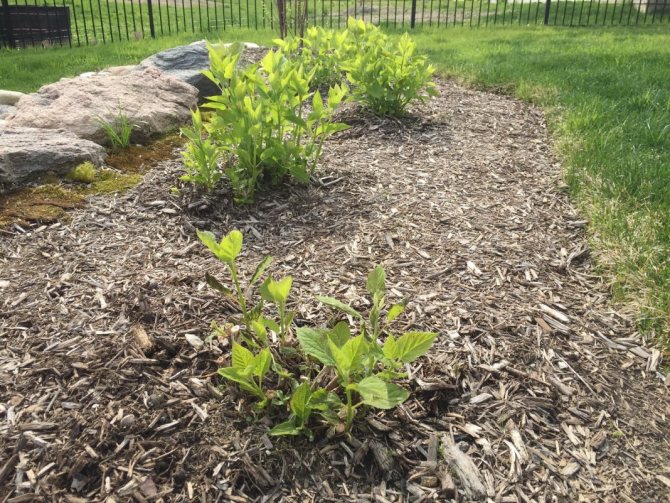

Mulching tree hydrangea.
Optimal cultivation
Treelike hydrangeas do well wherever there is excellent lighting.The scorching sun affects the decrease in the size of the inflorescences and a clear slowdown in the growth of the shrub. Too much shade in the place of growth affects the underdevelopment of inflorescences, their thinning and generally a decrease in flowering. When growing a shrub, it is necessary to ensure that the salt rays fall on it in the morning and in the evening.


Fertile loamy soils, which have high acidity and excellent drainage, are most suitable for hydrangeas. Here the undeniable love of mycotrophic plants for soil fungi is manifested. Compared to other varieties, the tree-like one tolerates lime in the ground better than others.
Features of agricultural technology
Hydrangea tree planting and outdoor care does not cause much trouble for the gardener, provided that certain rules are followed.
Garden hydrangea: planting and care in the open field
The process of growing a tree can be conditionally divided into several stages:
- Choosing a place for planting a plant... Hydrangea is not too whimsical to planting conditions, but there are some factors that affect the quality of its growth and flowering. The culture prefers warm, well-lit places. Desirably, the site should be protected from winds and drafts. Not shaded, but also without excess direct sunlight - it can burn the leaves of the plant. The flowers become smaller and the flowering process is not as plentiful. Ideally, this is a quiet, semi-shaded place.
- Soil preparation. Hydrangea prefers light fertile soils, preferably loamy. An important difference from most other plants is that the flower loves acidic and alkaline soil. To increase acidity, organic matter can be added to the soil: needles, sawdust, peat. From inorganic preparations, aluminum sulfate can be used. A solution of this drug with the calculation of 30 g per bucket of water is poured over the ground around the future planting.
An interesting pattern was noticed: the higher the acidity level, the richer the color of the flowers. Florists often add special dyes to the water in order to brighten the flowers.
Interesting. Gardeners do not recommend using ash as fertilizer for hydrangea. For this purpose, manure is better suited. If necessary, nitrogen-containing agents can be used for feeding in the spring, and potassium-phosphorus agents in the summer.
- Watering. Hydrangea is dependent on regular watering, especially during the hot summer season. The plant should be moistened with settled water, after sunset. In this case, you should not use the sprinkling method - this can cause burns to the leaves and contribute to the development of diseases. Watering should be done gently at the root. To better retain moisture, the soil around the tree can be mulched with sawdust or straw.
- Pruning... For abundant and large flowering, remember to carry out annual pruning of pagons. Gardeners advise pruning hydrangea pagons in the spring, leaving branches 20-25 cm long from the ground, where 2-3 buds are developed. At the same time, weak, thin and frozen pagons are removed. In the fall, pruning is not worth it, you can only remove dry branches.
- Hydrangea garter... The branches often do not support the weight of large hydrangea flowers, especially after rains. In order for the bush to look beautiful and the branches do not break, tying is required. There are several ways to solve the problem of how to tie a hydrangea. At this time, there are many options for hydrangea bush holders: round, rectangular, high, low, three or four legs. These devices are quite practical and beautiful, and fit well into the interior. But there are times when even the bush holders cannot withstand the load and break. Then you can use the trick of seasoned gardeners: the branches are neatly collected and can be tied with ribbons from spanbod (lutrasil). It is better to cut the strips 20-25 cm wide. This material is durable, resilient and does not interfere with the ventilation of the bush.In autumn and winter, the garter is visible, when the bush turns green, it becomes invisible.
Often gardeners are worried about the long absence of hydrangea flowering. It can be caused by several factors:
- The young age of the plant is less than 4 years;
- Poorly selected variety for a specific region. Heat-loving varieties do not have time to form buds in the short summer of the northern regions;
- Incorrect cropping. In case of frequent pruning, good buds are removed;
- Freezing shoots;
- Wrong planting site - shaded, unsuitable soil composition;
- An excess of nitrogen-containing dressings - all the plant's strength goes into the green mass.
When choosing a site for planting hydrangeas, you need to decide on the neighbors of the bush. Avoid planting a flower near tall trees or plants with shallow roots. The best option for the neighborhood of a culture with a fleshy root system is boxwood, astilba.


Features of agricultural technology
Preparing for winter
In autumn, dry, damaged branches are removed. In the northern and eastern regions, hydrangea needs insulation. This applies not so much to the roots as to the flower buds. Therefore, the plant is covered entirely. For this purpose, you can use spruce branches or lutrasil.
Important! In the spring, do not rush to remove the shelter - frost can seriously harm the hydrangea.
Hydrangea is a real gift for beauty lovers. A beautiful and unpretentious plant will delight you with the brightness and splendor of flowers for a long time. One has only to learn how to properly care for him.
Feeding hydrangeas
The lush bloom of this stunning plant cannot be overlooked, especially if the tree-like "Annabelle" hydrangea grows on the site. Planting and caring for this adorable shrub is very simple and the result is great. Who has ever stopped in front of a tall bush with pointed leaves and huge dense inflorescences that resemble viburnum? Spherical, white-cream inflorescences are pleasing to the eye from July to September, and the bush itself will grow up to 2.5 meters in height. Consider the size of the bush before planting it on the site.
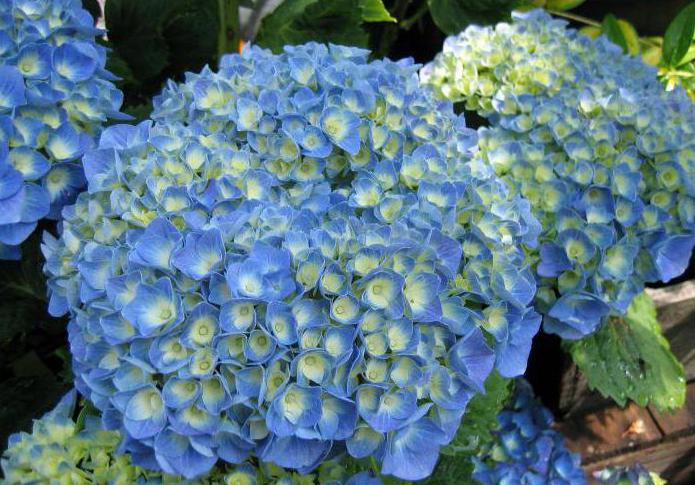

For lush flowering, the hydrangea bush needs regular feeding, especially if several years have passed since planting. Fertilization begins in the spring, when the bush is just starting to grow. For one square meter of soil, you need 25 g of urea, 40 g of superphosphate, 35 g of potassium sulfide. This mixture will ensure good shoot growth. At the moment when the buds begin to form, it is necessary to re-fertilize. To do this, you need 80 g of superphosphate and 45 g of potassium sulphide. This is enough for your bush to be covered with huge snow-white inflorescences. When the summer comes to an end, it is necessary to add organic matter to the soil in order to prepare it for the new season, to restore the balance of nutrients. To do this, under each bush, it is necessary to add at least 15 kg of rotted manure or compost.
Discoloration of inflorescences
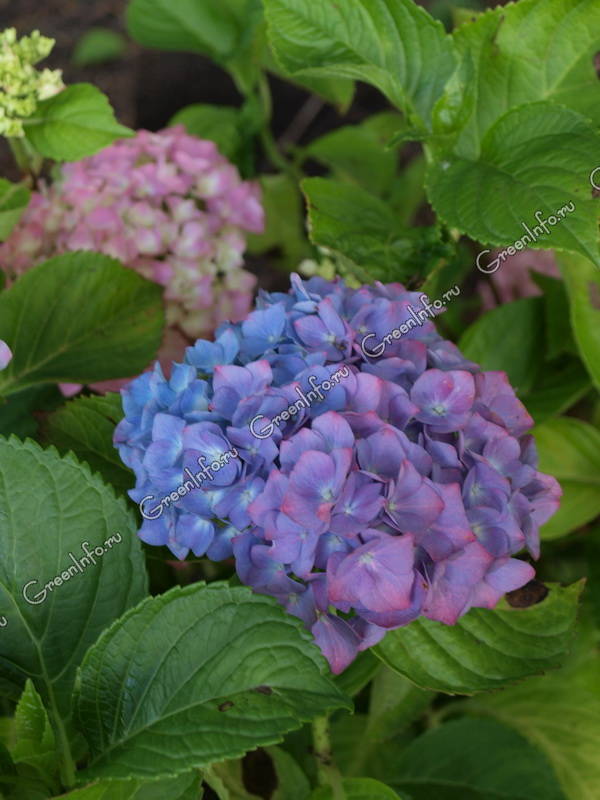

Large-leaved hydrangea
Hydrangea inflorescences of large-leaved, paniculate and ground cover cream and pinkish color, if desired, can be changed to blue, pale purple or blue. The fact is that the color of hydrangea flowers depends on the acidity of the soil. Pink and crimson flowers are with a slightly alkaline reaction, and they turn blue on acidic soil, while it must be borne in mind that white inflorescences practically do not change their color.
In an alkaline environment, hydrangeas are not able to use iron from the soil, on which the color of flowers depends (this nutrient is absorbed in an acidic environment). To get blue inflorescences on alkaline soils, plants are watered with a solution of iron salts. To enhance the blue color, iron shavings or small iron objects are buried under the bushes. The brighter the initial color of the inflorescences was, the more intense the blue or purple color will be.In some cases, both blue and pink inflorescences can appear on the bush at the same time. The inflorescences can turn blue if the plants were planted in peat soil, but the blue color can become dirty.
Photo: Alla Kuklina, Maxim Minin, Rita Brilliantova
How it differs from Strong Annabelle hydrangea
Hydrangea Strong Annabelle is one of the Annabelle species.
These two cultures are very similar to each other, but still, there are differences:
- flowering Strong Annabelle is more splendid and abundant, its flowers are larger;
- Annabelle blooms for only 3 summer months, Strong Annabelle blooms throughout the summer period and almost until mid-autumn;
- the stalks of Strong Annabelle are much stronger and more stable, they do not require additional strengthening, they are not afraid of wind and rain, which cannot be said about Annabelle, who bends to the ground in windy and rainy weather, becomes disheveled, can be damaged;
- Annabelle leaves keep green freshness until frost, Strong Annabelle leaves turn yellow much earlier.
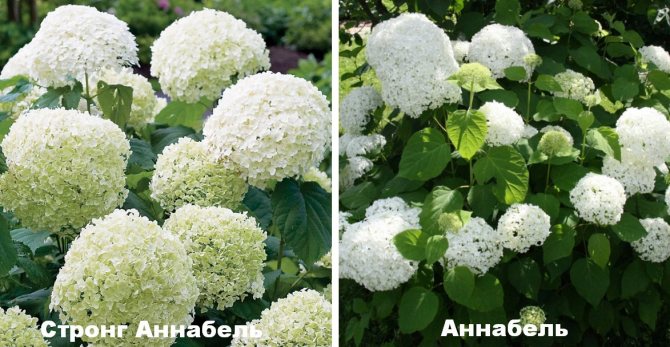

Strong Annabelle is an amazing plant characterized by a number of distinctive features. To appreciate all the beauty and sophistication of this culture, you need to be able to handle it correctly. And then for almost half a year it will be possible to admire this magnificent beauty.
Transfer
Culture transplantation is carried out in spring and autumn in the Krasnodar Territory, Rostov Region and regions with similar climatic conditions. In the Voronezh region and to the north, tree hydrangeas are planted only in March - April, after the snow melts.
They transfer the plant to a new place along with a clod of earth, without shaking off the soil and not exposing the roots.
The hole is prepared in advance. A layer of humus, peat, lake silt is laid out on the bottom. Hydrangeas will need these fertilizers for successful rooting. The bush begins to feed one month after transplanting.
The lump is placed in a hole and covered with a soil mixture of deciduous humus and garden soil. The transplanted hydrangea is watered abundantly.
Bush pruning is done before the plant is transferred to a new location. All shoots are shortened by one third of their length. The branches are cut in half if the roots were damaged during transplantation. So the bush will take less life juices to provide. The roots, immediately after being transferred to a new place, experience stress and cannot provide the above-ground part with the required amount of nutrients.
Important... A light shelter is organized for the transplanted plants, protecting the bush from the scorching sunlight. They are watered regularly, preventing the soil from drying out.
Photo
Treelike hydrangea is a very hardy plant and one of the most popular among gardeners. And the snow-white Annabelle variety blooms from early July until September.
Sunset color miracle
Indeed, we are already used to white spherical inflorescences, but a bush hung with inflorescences of other flowers is a completely different picture that attracts most gardeners. The bush of a plant of this variety is somewhat different, its height is not more than one and a half meters, and the inflorescences are formed large, over 30 cm long. At the same time, the flowers remain on the bushes for a very long time, gradually changing their color from cream or greenish to pale pink or even red. Hydrangea grows very quickly, due to which it has earned the recognition of gardeners. The charming, graceful bush, covered with lovely dangling buds, can become the centerpiece of a garden or form a stunning hedge.


Plant care
Like any plant, hydrangea tree care in the form of fertilizing, mulching, watering and pruning is necessary constantly.
Top dressing hydrangeas
The general condition of the plant, as well as the abundance of flowering, largely depends on the timeliness of fertilizing, especially with low soil fertility.
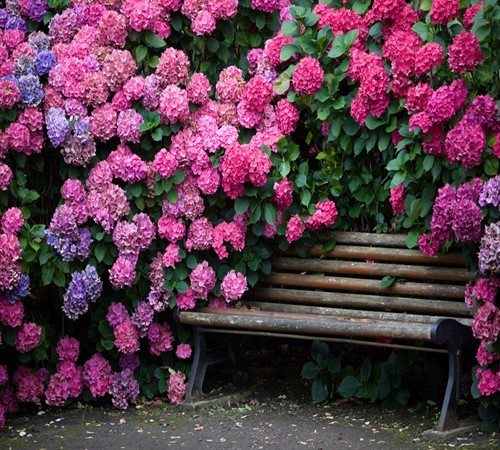

The necessary feeding can be divided into 3 stages:
- after 2 weeks from the moment the plant is planted in the ground, the plant is fed, consisting of a mixture of potassium sulfate (25 g), urea (20 g) and superphosphate (40 g). The frequency of carrying out - annually in early spring, and with fertile soil, it is enough to fertilize in a year;
- during the period of bud formation, hydrangea must be fed with mineral and organic fertilizers. For this purpose, ready-made preparations of the "Kemira-flower" type, which contain various macro- and microelements necessary for hydrangeas, are quite suitable. An alternative option is a fertilizer containing 50-60 g of superphosphate and 30-40 g of potassium per 1 m². Do not exceed the dosage of nitrogen, since its excess leads to a change in the color of the petals with a predominance of a greenish tint. In addition, in hydrangeas overfed with nitrogen, frost resistance is significantly reduced, which can lead to the death of the plant after a harsh winter;
- the final top dressing at the end of August is the introduction of 15 kg of rotted manure per 1 m² into the soil.


From the beginning of September, all feeding must be stopped so that the hydrangea stems have time to lignify by winter.
Watering the hydrangea
Despite the fact that the roots of the plant grow horizontally, on warm and especially sultry days, hydrangea must be watered every 2 days, moistening the soil 50-60 cm in diameter 1 m, thereby creating a small supply of moisture. In addition, once a month during the season, the bushes need to be watered with water with a small addition of manganese to increase the strength of the current shoots.
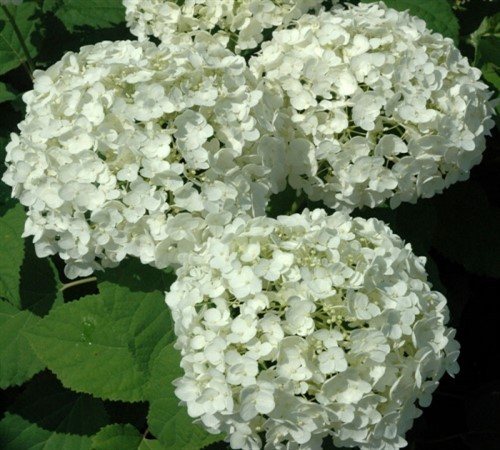

Mulching hydrangea
An integral way of caring for hydrangeas is mulching, which prevents the plant from overheating in hot weather. In addition, by mulching, it is possible to get rid of some of the weeds that deprive the hydrangea of its water supply and some of its nutrients.
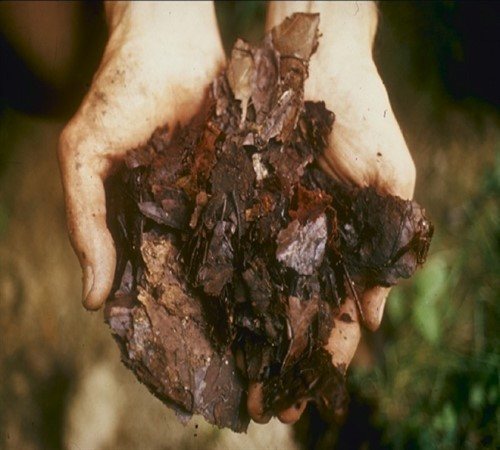

When mulching in spring, it is advisable to add a small layer of peat, about 10 cm, or a mixture of compost with sawdust, which increase the acidity of the soil, creating favorable conditions for growing a plant under the hydrangea bush.
Pruning hydrangea
The hydrangea bush grows rather quickly, so the plant must be pruned in the spring and autumn every year. Pruning is carried out no earlier than 3-4 years after planting, since young plants have increased sap flow in spring and any damage to the shoot can lead to the death of the entire plant.
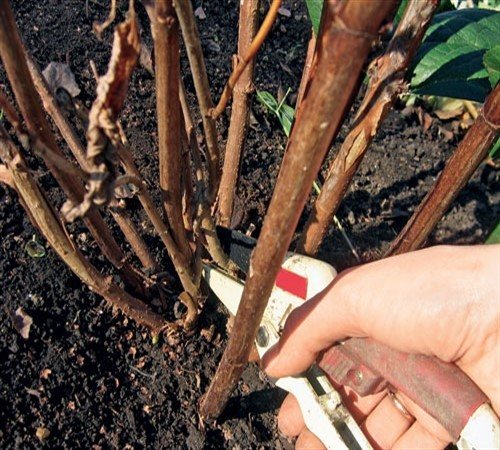

There are 4 stages of spring pruning:
- prevention - inspection of the bush for broken, frozen branches and their removal;
- rejuvenation - intended for plants growing over 5 years. The rejuvenation process consists in removing old shoots that consume a large supply of nutrients and prevent the normal development of new shoots;
- formation - the processes of the previous year are to be shortened to 3-4 pairs of buds;
- thinning - getting rid of small shoots that do not form inflorescences, but only thicken the bush and take nutrients from the hydrangea.


Timely pruning of hydrangeas is necessary to give the bush a certain shape, improve flowering, and also adjust the number of inflorescences.


In the autumn, when the hydrangea has faded, it is necessary to remove withered and dried inflorescences.
Shelter for the winter
Despite the ability of the frozen hydrangea to recover, it is better not to risk it and take measures to cover it with the onset of recurring frosts. This requires:
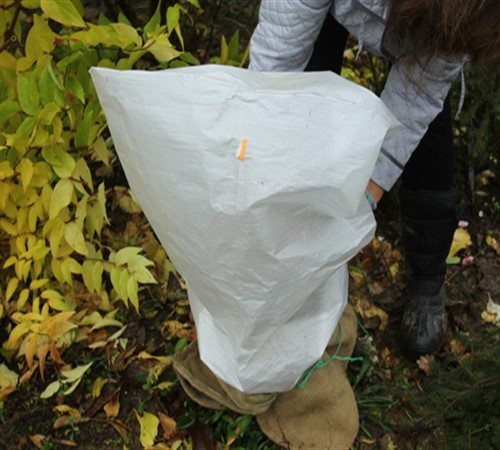

- remove loose leaves from the bush;
- cover the base of the hydrangea with sawdust;
- put boards around the bush and attach plant stems to them with ropes;
- cover with cellophane and cover with sawdust.
Such a shelter will definitely preserve the viability of the plant even in the most severe winter.


Thus, a tree hydrangea, planting and caring for which requires a significant amount of time, will delight the owner with its decorative appearance for a long period.
_ _ _ _ _ _ _ _ _ _ _ _ _ _ _ _ _ _ _ _ _ _ _ _ _ _ _ _ _ _ _ _ _ _ _ _ _ _ _ _ _ _ _ _ _ _ _ _ _ _ _ _ _ _ _ _ _ _ _ _ _ _ _ _ _ _ _ _ _ _ _ _ _ _
Modern varieties
In fact, this plant has been decorating the gardens of our compatriots for so long that it may seem boring and boring. However, breeders do not sit idle and develop new varieties. One of these new products is the tree-like hydrangea "incredibol". Planting and leaving involves the provision of the necessary conditions (soil, watering, feeding) and the obligatory garter or installation of a wicker circular fence on which the shoots will rest. Otherwise, heavy inflorescences will break the shoots. This variety is distinguished by the largest globular inflorescences, about 30 cm in diameter.
How to plant a tree hydrangea correctly
Planting and caring for tree hydrangeas in the open field begins with a competent choice of a place for the plant. It should be borne in mind that this flower does not accept frequent transplants. It feels great in one place for many years, so you need to find such an area on the site where the hydrangea could live all its life. It should be borne in mind that the hydrangea tree loves:
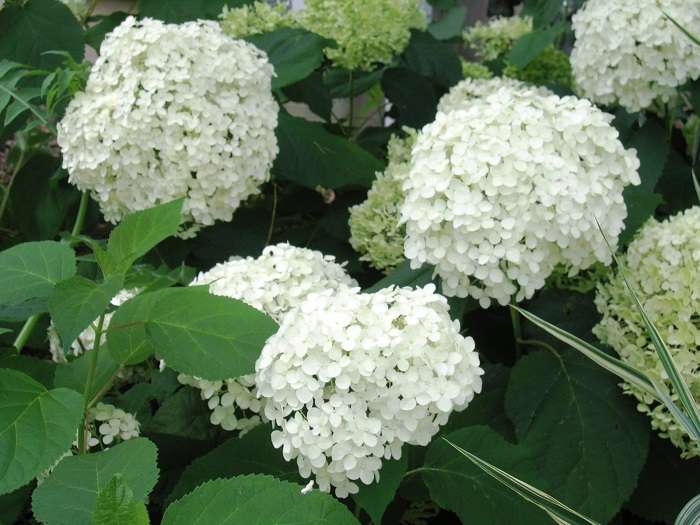

- she does not tolerate constant exposure to direct sunlight;
- develops well in partial shade, when neighboring vegetation provides scattered light on it;
- hydrangea grows poorly near fruit trees, the rhizomes of which absorb nutrients and moisture from the ground.
As for the soil, the plant is not too demanding for it. It should be an ordinary fertile soil with a neutral or, better yet, high acidity level. You can add sawdust, peat-based mixtures and pine needles to the ground. Experienced gardeners argue that the higher the acidity of the soil, the more intensely the hydrangea blooms, and the richer the color of the flowering looks.


Before planting a tree hydrangea, it is necessary to seriously approach the choice of a seedling. It must meet the following parameters:
- age at least 2-3 years;
- the size is not less than half a meter in height;
- it must have at least 2 live shoots;
- the presence of several large, prone to developing kidneys;
- the bark is healthy, not damaged by anything.
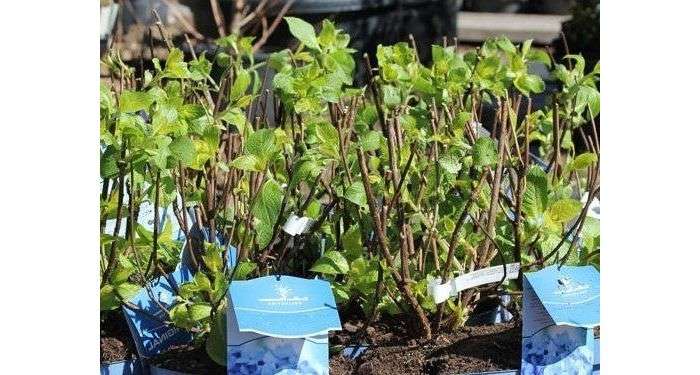

If the seedling was purchased with open roots, it must be immersed in the ground as soon as possible. Tree hydrangea, when to plant? Planting time is either spring or autumn. Both options are only suitable if the soil is warm enough and the weather is already or is still warm outside. And yet, planting a tree hydrangea in the fall is not as effective as in the spring.


When several bushes are planted in open ground at once, each of them should be allocated at least a square meter of personal space. Plants placed too densely will not develop. The hole should be about half a meter deep. Maybe less, maybe more. You need to look at the roots: when the hydrangea is immersed in the ground, they cannot be bent. The root system should feel free.


First, a thin layer of drainage is made from ordinary stones. Further, a hydrangea is immersed in the pit, so that its root collar is at the level of the upper layer of the earth. The root system is carefully covered with a substrate consisting of:
- humus;
- peat;
- compost.
The usual garden soil is poured out from above and compacted quite abundantly so that excess air comes out. The soil is watered with warm water - half a bucket will be enough. The final touch of planting is mulching the soil near the trunk. This procedure keeps moisture in the ground.
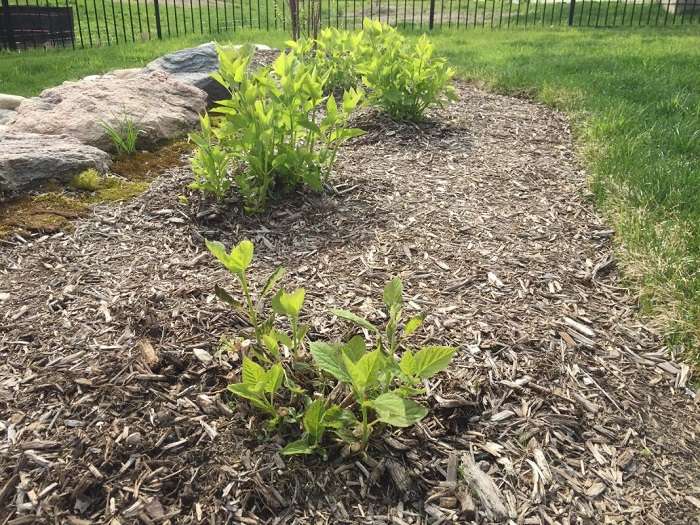

Reproduction of hydrangeas
Hydrangea is propagated by cuttings, dividing bushes, grafting or seeds. The best time to successfully root hydrangea cuttings is during the flowering period (mid-July).Small one-year lateral shoots are suitable for cutting cuttings, which are formed in sufficient quantities on each plant. They should not break when bent. Strong and thick shoots with hard wood, taken from well-lit parts of the crown, take root less well. Hydrangea can be cut before flowering (in June), in this case, when cutting the cuttings, a piece of last year's shoot is retained at its base - the cut "with the heel" is cut off.
For rooting cuttings, a light, moisture-absorbing substrate is prepared from high-moor peat and well-washed coarse-grained sand (in a ratio of 2: 1). Sand is poured on top with a layer of 2 cm. The slightly acidic reaction of peat promotes root growth. To increase the moisture capacity, chopped sphagnum moss can be added to the substrate. For rooting, cuttings are powdered with Kornevin. When planting, the cuttings are deepened into the substrate by 2-3 cm, placing them at a distance of 3-5 cm from each other with a slight slope. Rooting of hydrangeas occurs in 3-4 weeks at a temperature of 16-20 ° C and slight shading. (For more information on the technology of cuttings, see the article Green cuttings of woody plants)
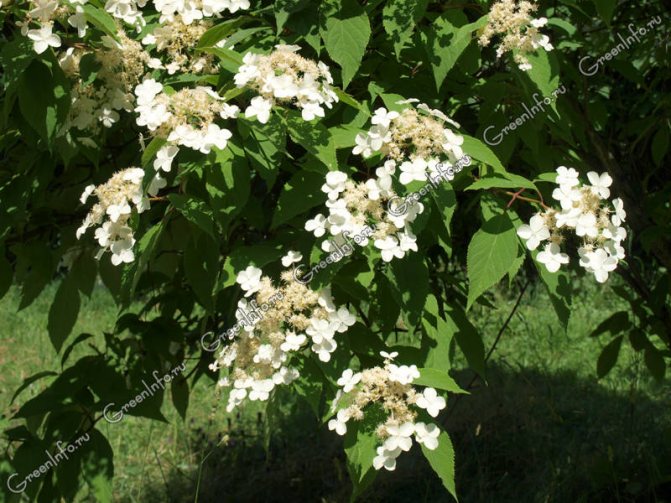

Hydrangea Bretschneider
Hydrangea can also be propagated by dividing the bush. In spring or autumn, the bush is dug up, divided into 2-3 parts, so that at least 2-3 renewal buds remain on each plant.
Seed propagation of hydrangeas is more troublesome and not suitable for varietal plants. Due to the fact that its seeds are very small, it is safer to sow in boxes. The soil substrate should be light with a slightly acidic reaction of the medium. It is prepared from leafy soil, humus, peat and coarse sand (in a ratio of 2: 2: 1: 1). Seeds are sown superficially without stratification, only lightly sprinkled with sand. For seed germination, crops are regularly watered using a sprinkler. Seeds sown in spring (from March to May) sprout in a month. In order for the seedlings to develop normally, liquid fertilizing with complex fertilizer is needed. By autumn, they grow up to 30-40 cm in height. Seedlings overwinter in open ground under a reliable shelter.
What is she - tree hydrangea
Treelike hydrangea is a type of garden hydrangea, belongs to the genus Hydrangea. She is originally from North America. It grows in the wild on the Sakhalin Peninsula, and is also found in Japan and China. In gardening, its other name is popular - white artisanal hydrangea. Many varieties of this shrub have already been bred.
The brightest and most popular:
- hydrangea tree annabel - absolutely not afraid of cold weather;
- hydrangea tree-like pink annabelle - resembles lilac flowers with lush pink buds;
- hydrangea tree-like incredibol - changes the color of the flower during the entire flowering period;
- hydrangea Hayes Starburst tree-like - frost-resistant variety, blooms before frost;
- hydrangea pink pinkushen tree-like - differs in the shape of inflorescences - it is pyramidal;
- treelike terry hydrangea - very fluffy, like a fur ball;
- hydrangea treelike grandiflora - loves partial shade and easily tolerates drought;
- bounty hydrangea is tree-like - it has snow-white flowers that gather in a large bouquet, it likes a lot of light.
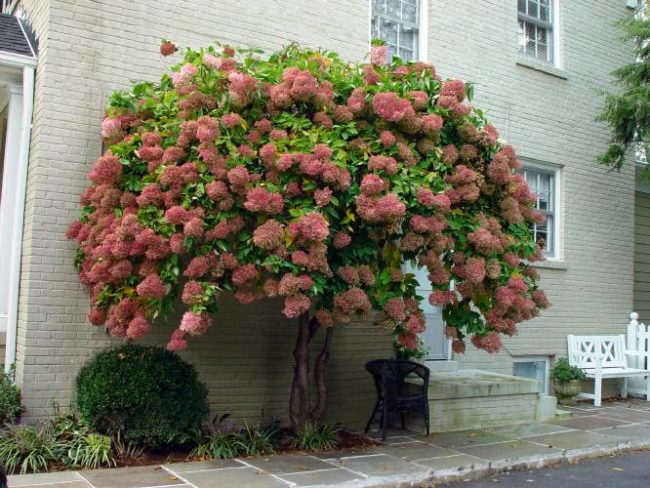

Thus, the varieties of hydrangea tree-like are diverse and everyone can choose something at their discretion. The flower belongs to those plants that are spectacular both in single and group plantings.
Shrub wintering
The process of preparing the garden for winter will not give you any trouble if the tree-like pink hydrangea grows in the garden. Planting and leaving are absolutely identical to those we have already described. A well-rooted strong plant will endure the winter without any problems, without requiring additional shelter. However, it must be borne in mind that the roots of the shrub are located very close to the surface of the earth. So that early frosts do not destroy them, the bush must be well spud and the soil under it must be mulched.And so that the branches do not break under the weight of the snow, they should be tied. But young plants, which will have their first wintering, should be covered with hay or sawdust, dry leaves. However, as we have already said, this plant easily tolerates wintering. Even if the shoots are slightly frozen, the bush will recover easily and quickly. With proper care, the hydrangea bush will become a real decoration of the garden and will delight you with flowers of stunning beauty. We mentioned a very interesting variety of hydrangea - panicle. Let's take a look at its features separately.
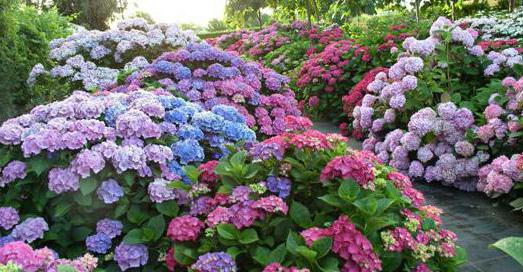

Sterilis variety
If you want to decorate your site for a long time, then you should like the tree-like "sterilis" hydrangea. Planting and care consists in choosing the right soil and sufficient watering. This is enough for the bush to grow quickly and delight you with its stunning flowers. Usually, it is enough to plant a strong seedling in September so that it blooms beautifully next summer. This variety has a long flowering time, you can admire it from June to October, and maybe longer if the early frosts do not kill the color. Thick and heavy inflorescences bend the branches, so it is best to plant the bush in a special basket without a bottom, the openwork walls of which will support the shoots. The inflorescences are greenish at first, and only over time they become pure white.
Care
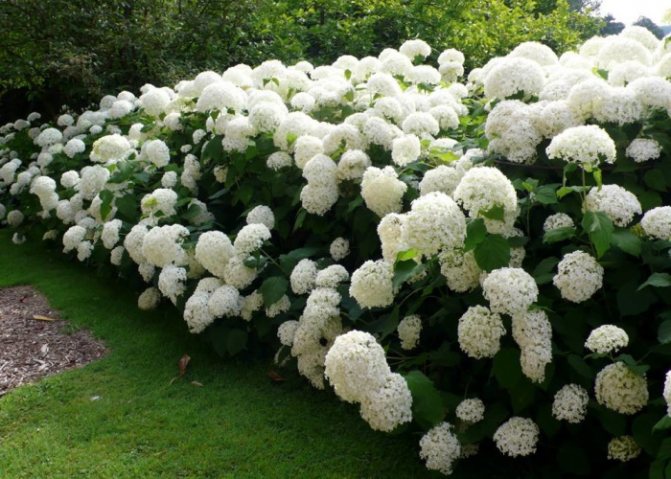

Any garden culture grows well and blooms if it is watered and fed in a timely manner. Care is organized taking into account the region where the culture is growing. In the south, where the summer air temperature exceeds + 40 degrees, garden crops are watered more often.
Watering
Hydrangea does not tolerate dry periods. She especially needs moisture in summer. For horticultural crops, several watering methods are used:
- drip irrigation system;
- full bay of the beds;
- root irrigation from a hose.
Watering frequency depends on the region, summer air temperature, regularity and amount of precipitation. In the middle lane, where the air temperature in summer is rarely more than +32 degrees, flower beds can be watered once every 7 days. In the south, this is done every 3-4 days. Each bush requires one and a half to two buckets of water.
You can water the garden in the middle lane in the morning and in the evening. In the south, where it is hot already at 8 in the morning, plants are given a shower after 6 pm and at dawn from 5 to 7 hours. The drip irrigation system can work all day long.
Top dressing
For garden bushes, four dressings per season are enough. The first is carried out in early spring, after the buds begin to open and shoots appear. To stimulate the growth of hydrangeas, nitrogen-phosphorus fertilizers are used. Ready-made complexes designed for flowering garden plants are suitable for feeding.
The second feeding is carried out during the budding period. Potassium, phosphorus and nitrogen are added to the soil. The third time the bushes are fed already during flowering, and then in the fall before the hydrangea goes into hibernation.
Table 1. Amount of preparation in grams per 10 liters of water.
When applying fertilizers, take into account their ability to interact with each other. There are groups of substances that create compounds that plants are unable to assimilate. Others, on the contrary, reinforce each other's action.
Table 2. Compatibility of trace elements


Soil care
In the summer, it is difficult to cultivate the land under the flowering branches of highly overgrown hydrangea bushes.
In early spring, after the shoots came out of the ground, a layer of mulch from a suitable material is laid around the bush at a distance of 5-7 cm from the trunks and stems:
- sawdust,
- peat,
- chopped bark;
- wood chips.
In some cases, a mulching black film is used. This material retains moisture well, prevents weeds from growing. The only drawback of the film is its appearance. To make the hydrangea lawn look decorative, the synthetic mulch is covered with a layer of small pebbles.
Treelike hydrangea can grow on a lawn with lawn grass. In this case, weeding will not be necessary. The lawn is regularly trimmed, and weeds do not grow under the branches of the shrub, thanks to the mulch layer.
Pruning
Dry and broken off branches of the hydrangea are removed in spring and autumn. Faded inflorescences are cut with pruning shears so that they do not spoil the appearance of the shrub. Before the plant wakes up after hibernation, the frozen shoots are removed from it.
One-year-old shoots are shortened, leaving shoots with 3-5 buds. It is not recommended to cut branches to 2-3 buds. In this case, the flowering will become sparse and scarce.
Thinning a bush for flowering is carried out as follows:
- remove small lateral branches, weak shoots;
- branches formed in the previous season are shortened to 4 buds. Inflorescences will be formed from them.
After a cold winter, remove all frozen branches. No more shoots are cut off from the plant. The remains of the aboveground part will be needed by the hydrangea for full recovery.
Rule # 7. Support for fragile shoots
The large caps of the inflorescences are often too heavy for the slender and flexible branches of the hydrangea tree. Lodging or breaking off branches in a rainstorm or strong wind is not so uncommon. If the hydrangea forms especially large inflorescences, then it is better to tie the bushes in time or tie up the shoots to the supports - surround the bush with a "ring" of pegs (according to the same principle by which bushes of herbaceous peonies are tied up unstable to lodging).
For the same purpose, you can add hydrangea with a solution of potassium permanganate several times in the spring. Such watering increases the strength of the shoots of the tree hydrangea. A solution of potassium permanganate can also be used to spray the crown.



